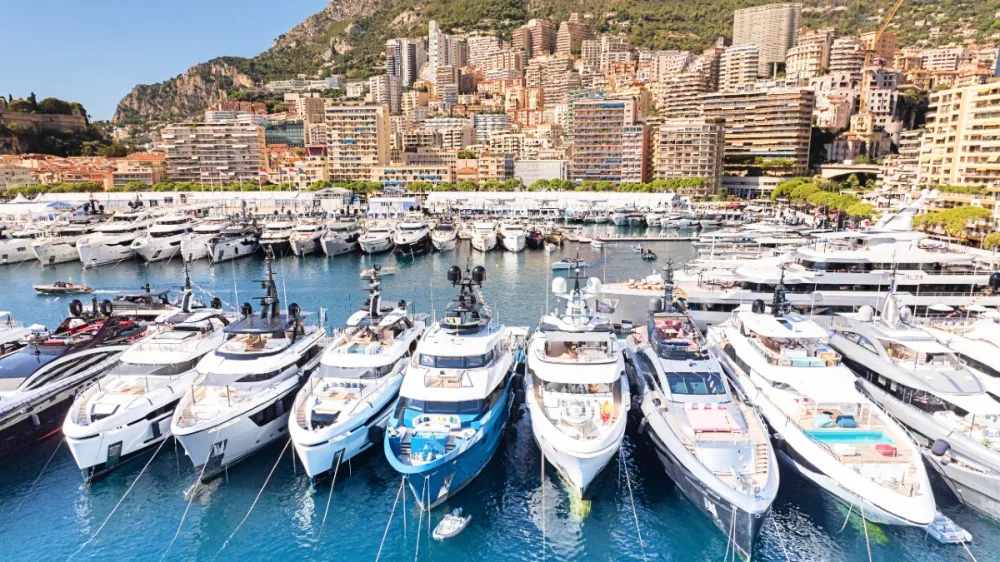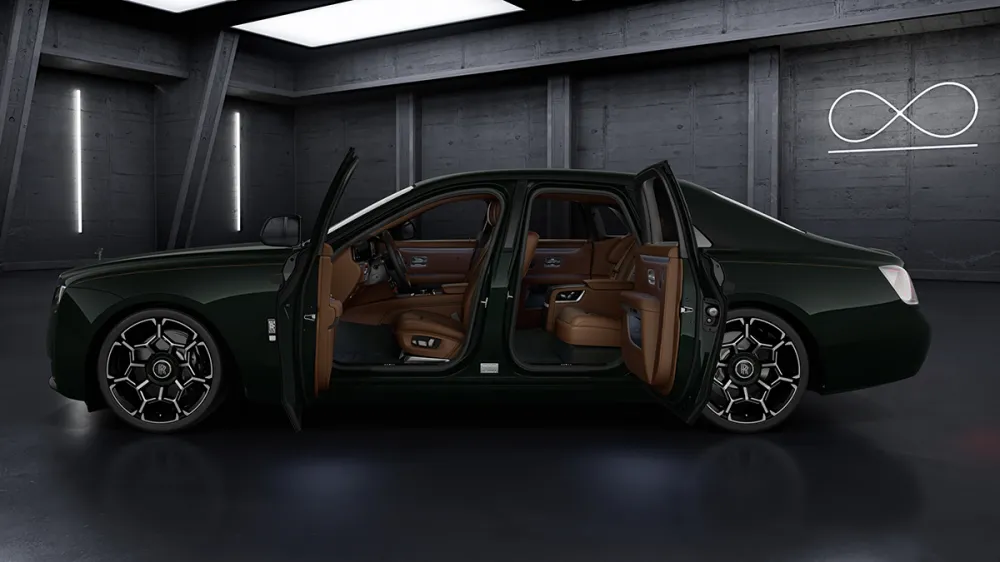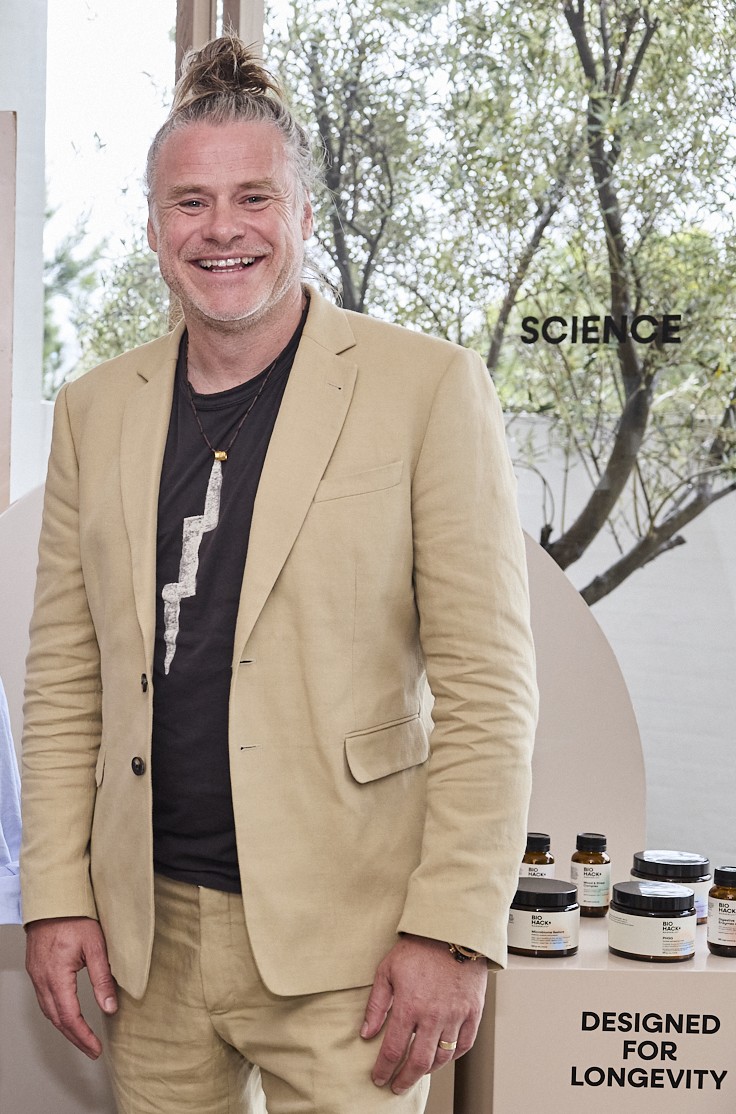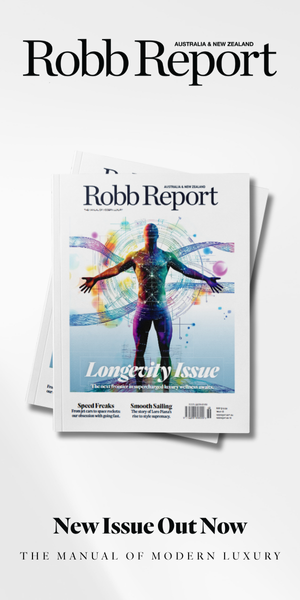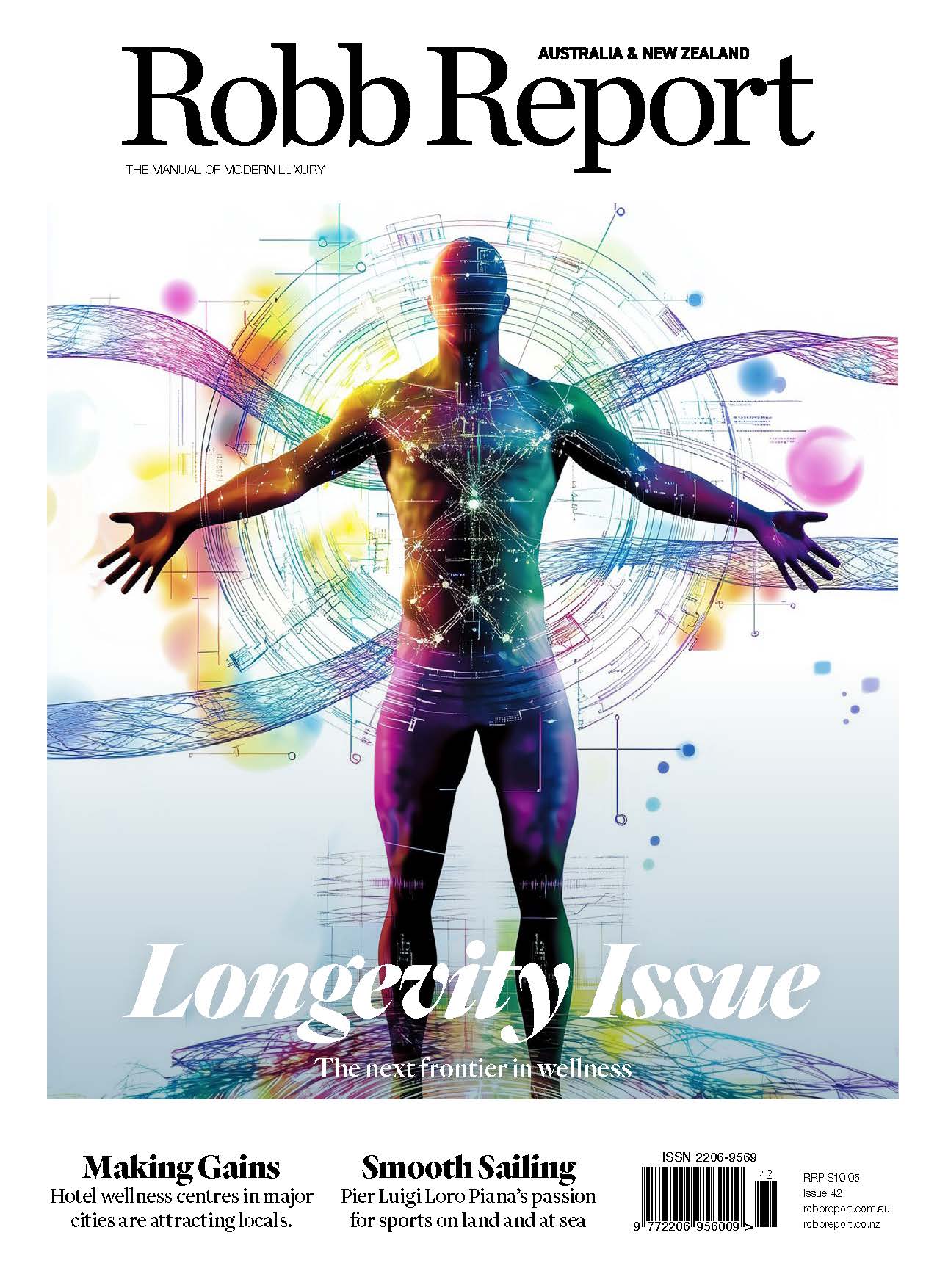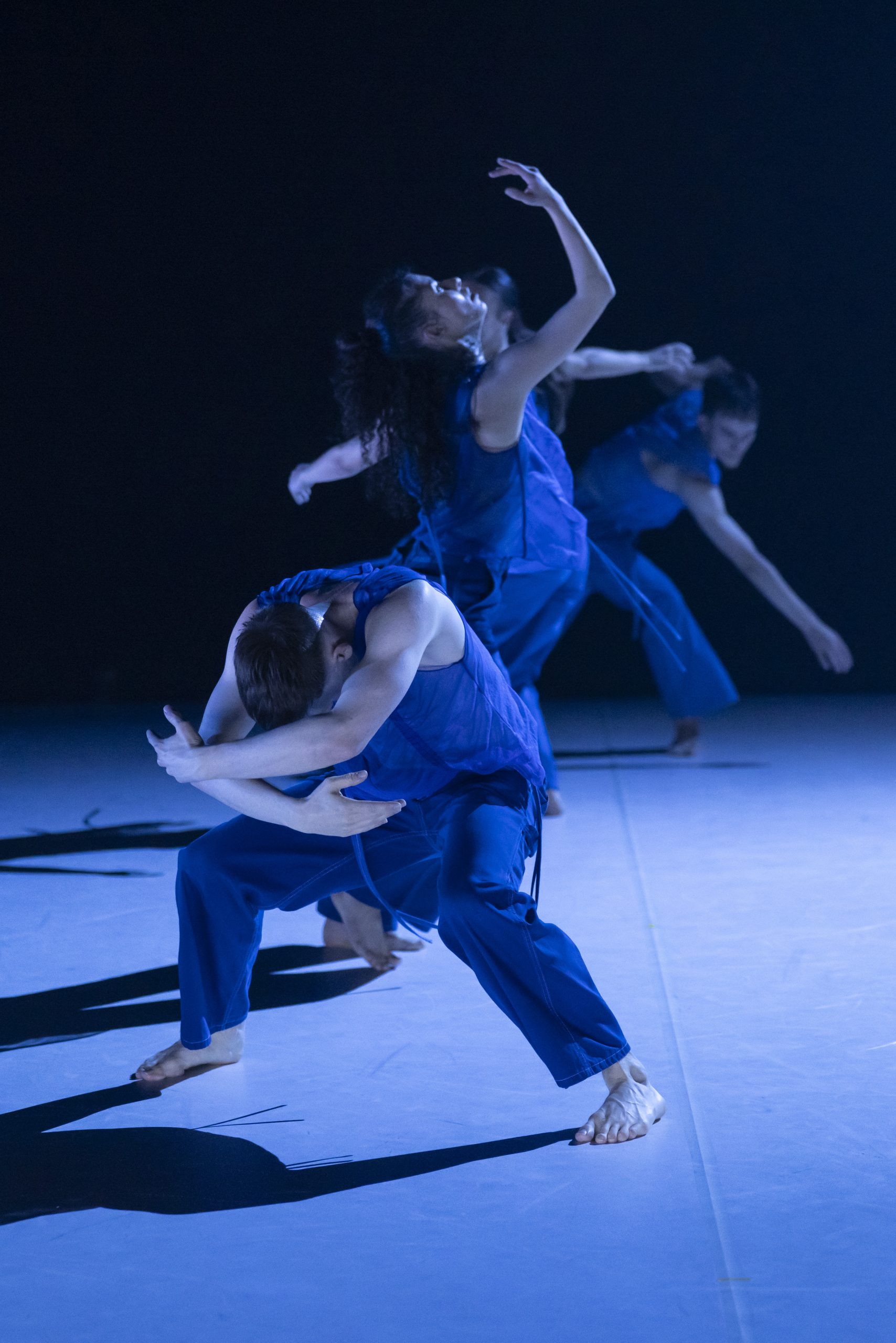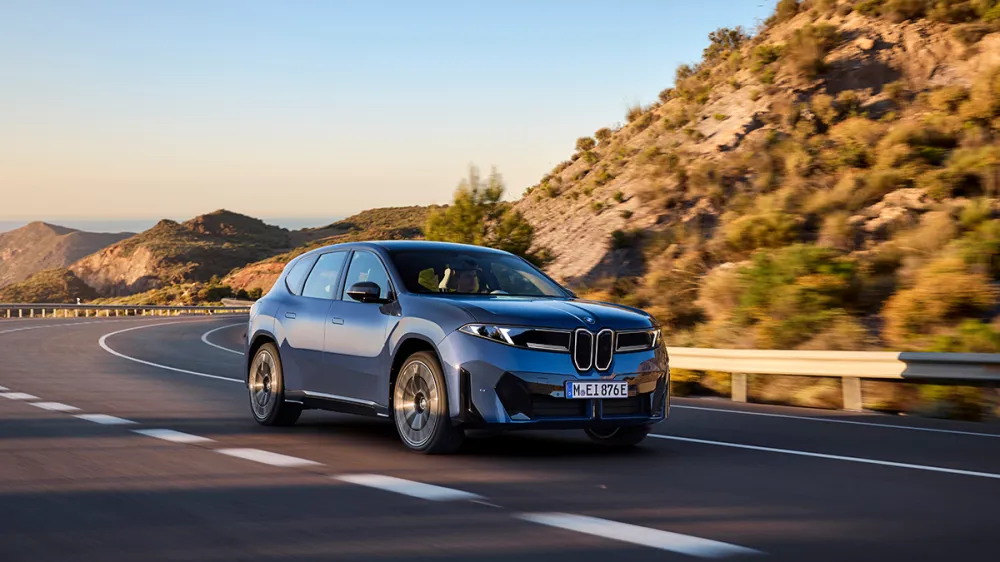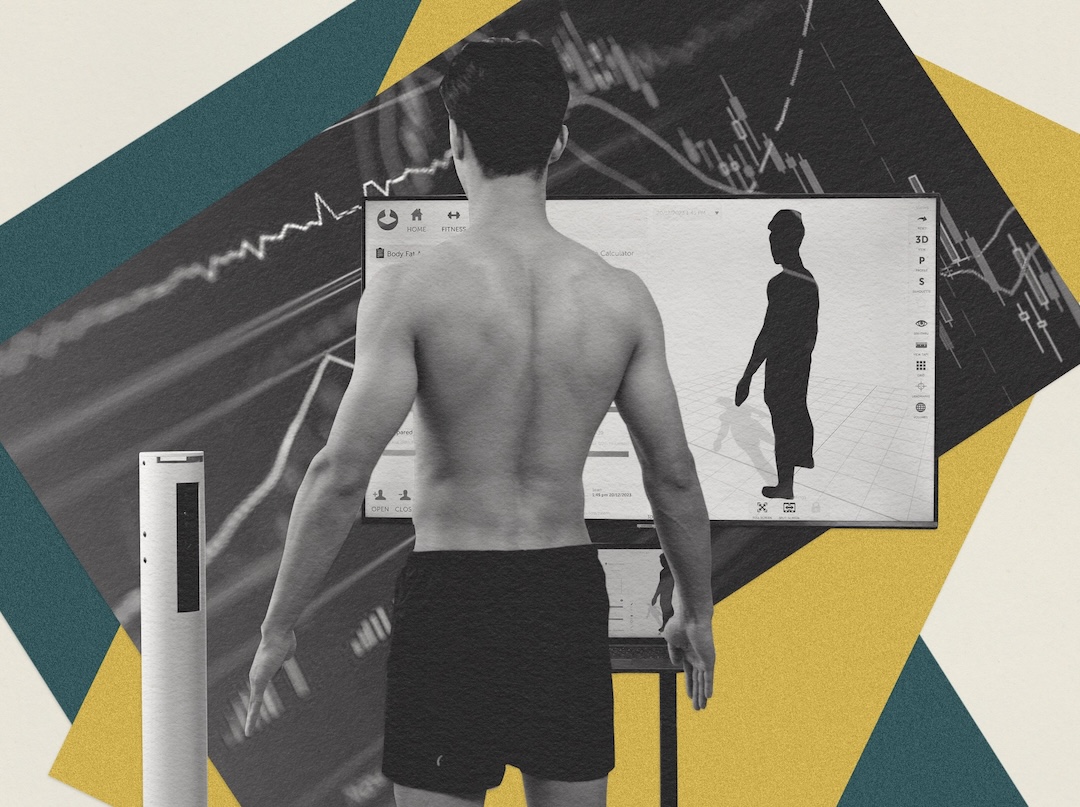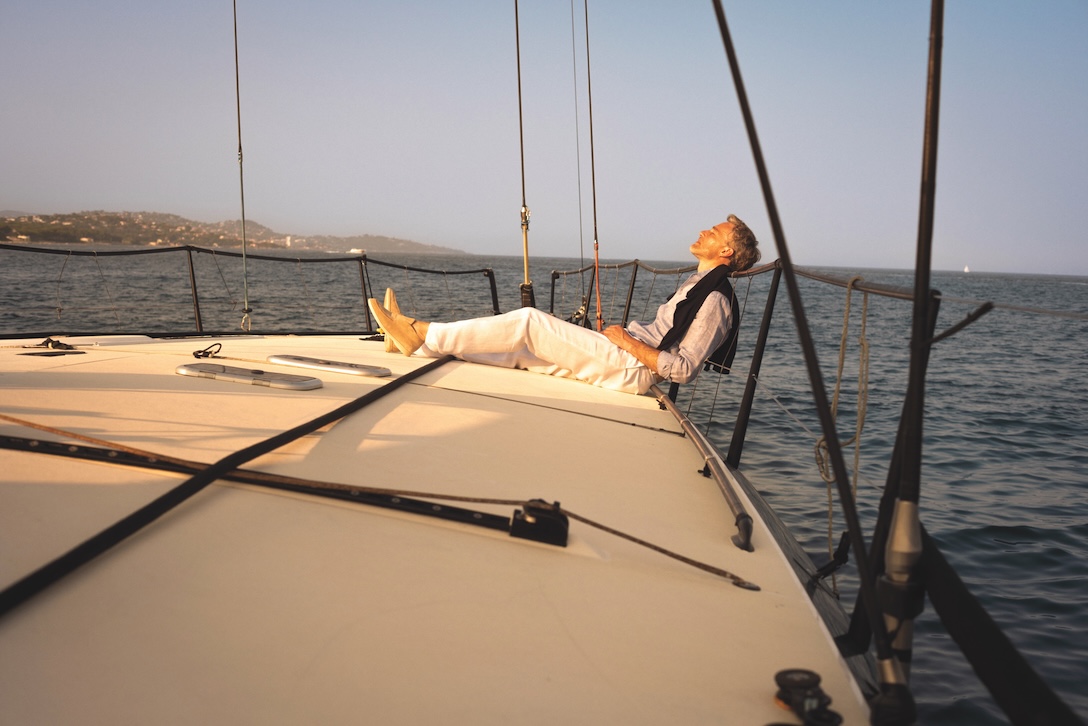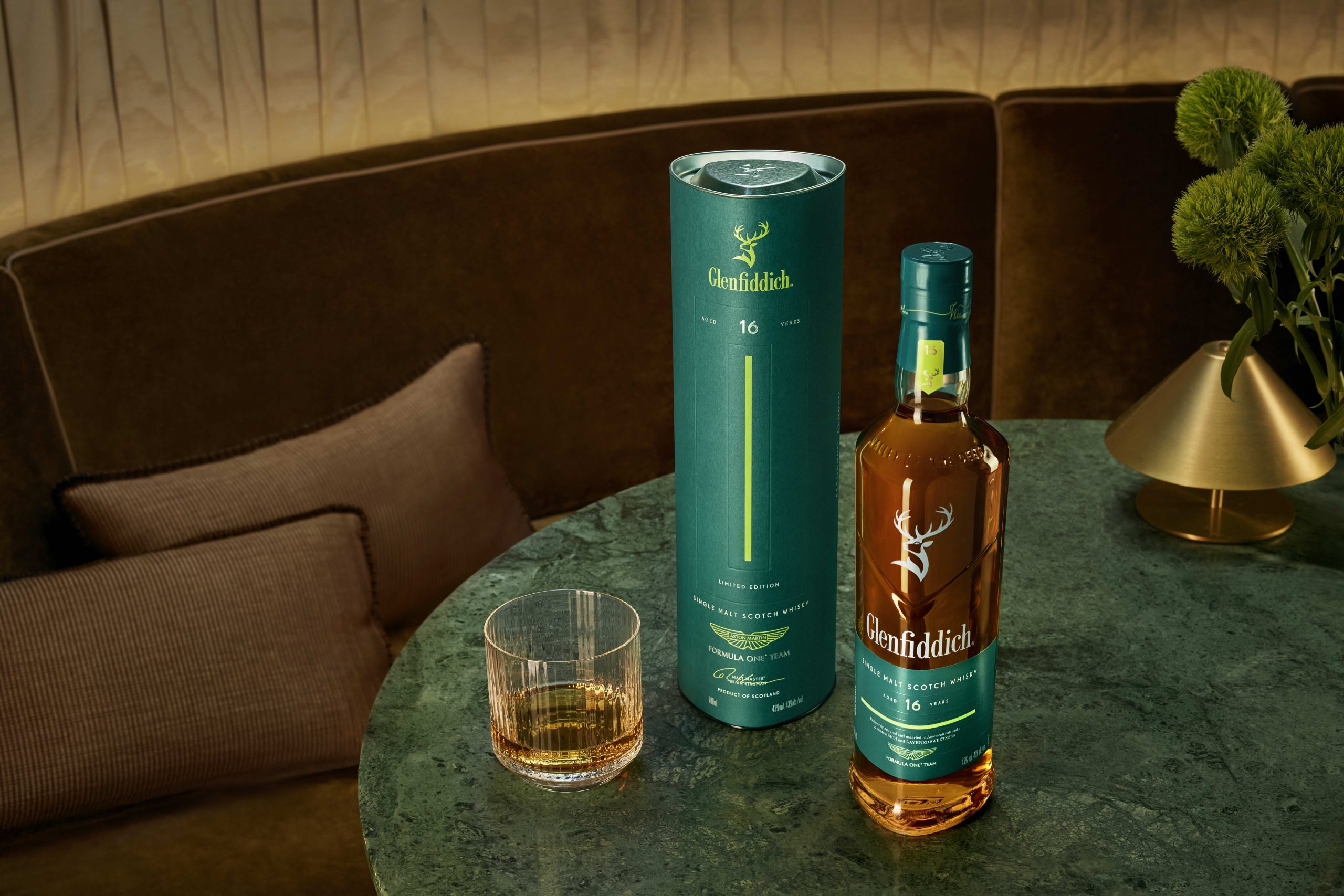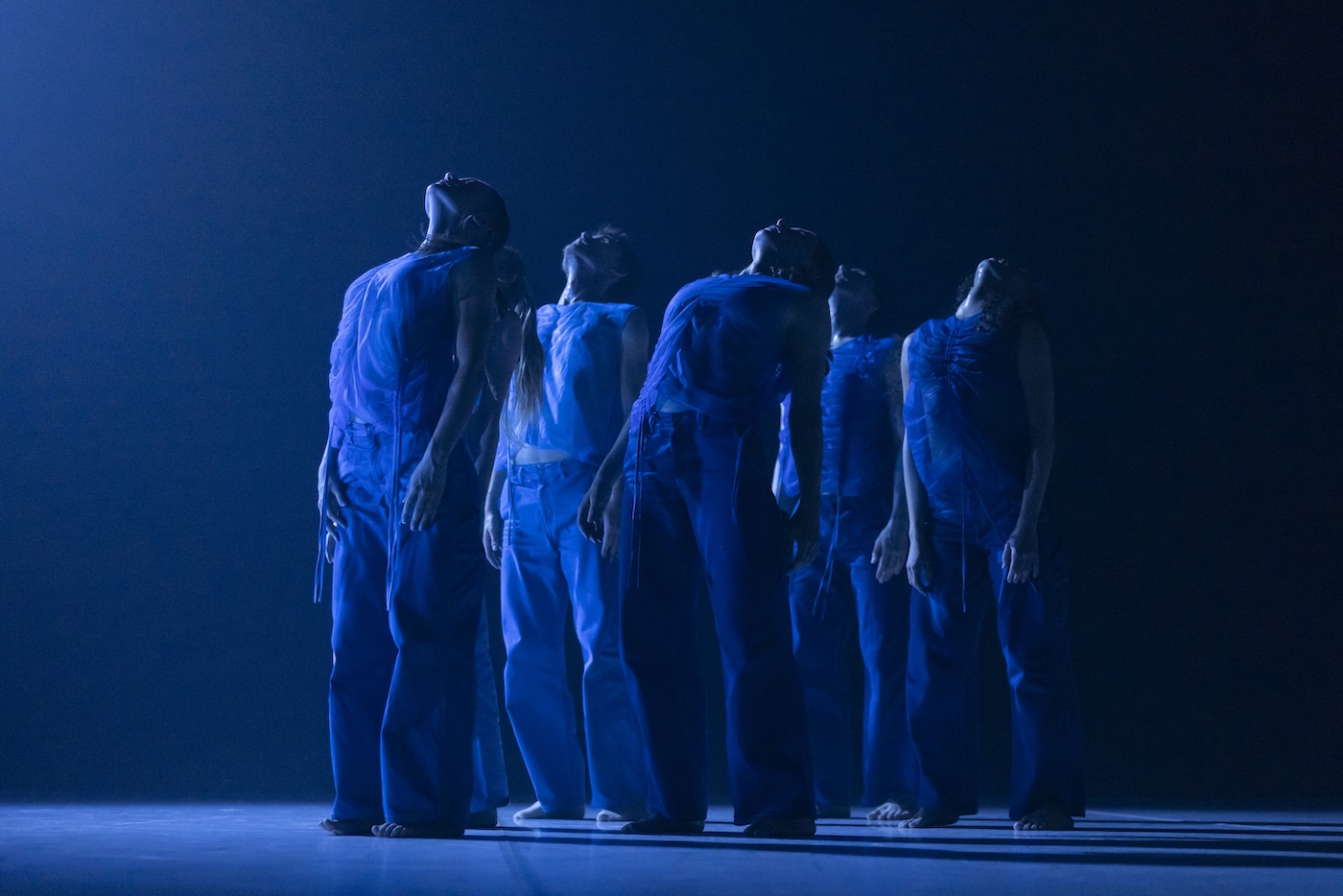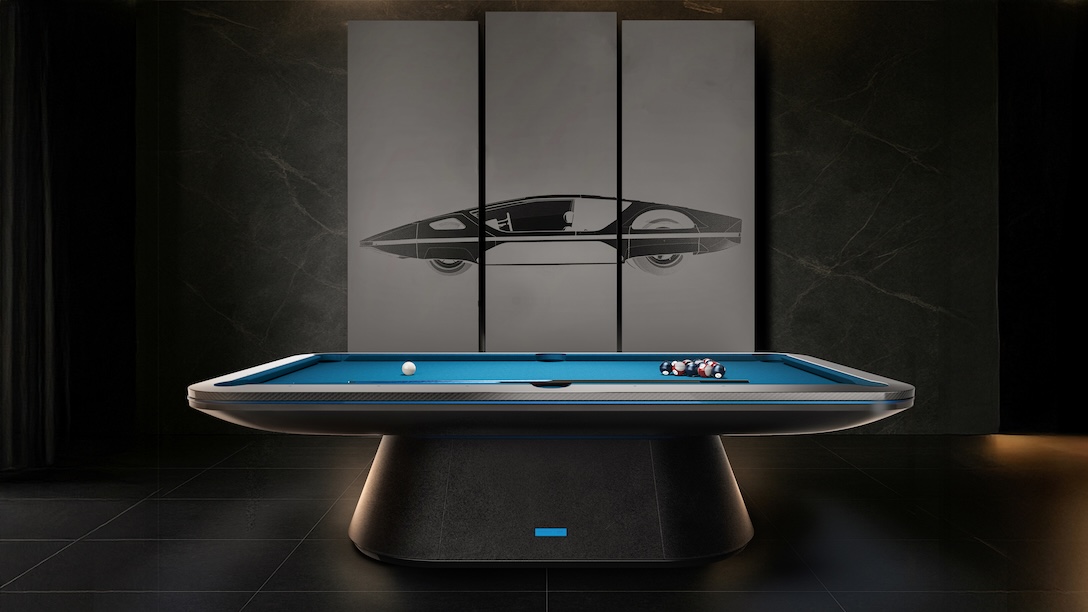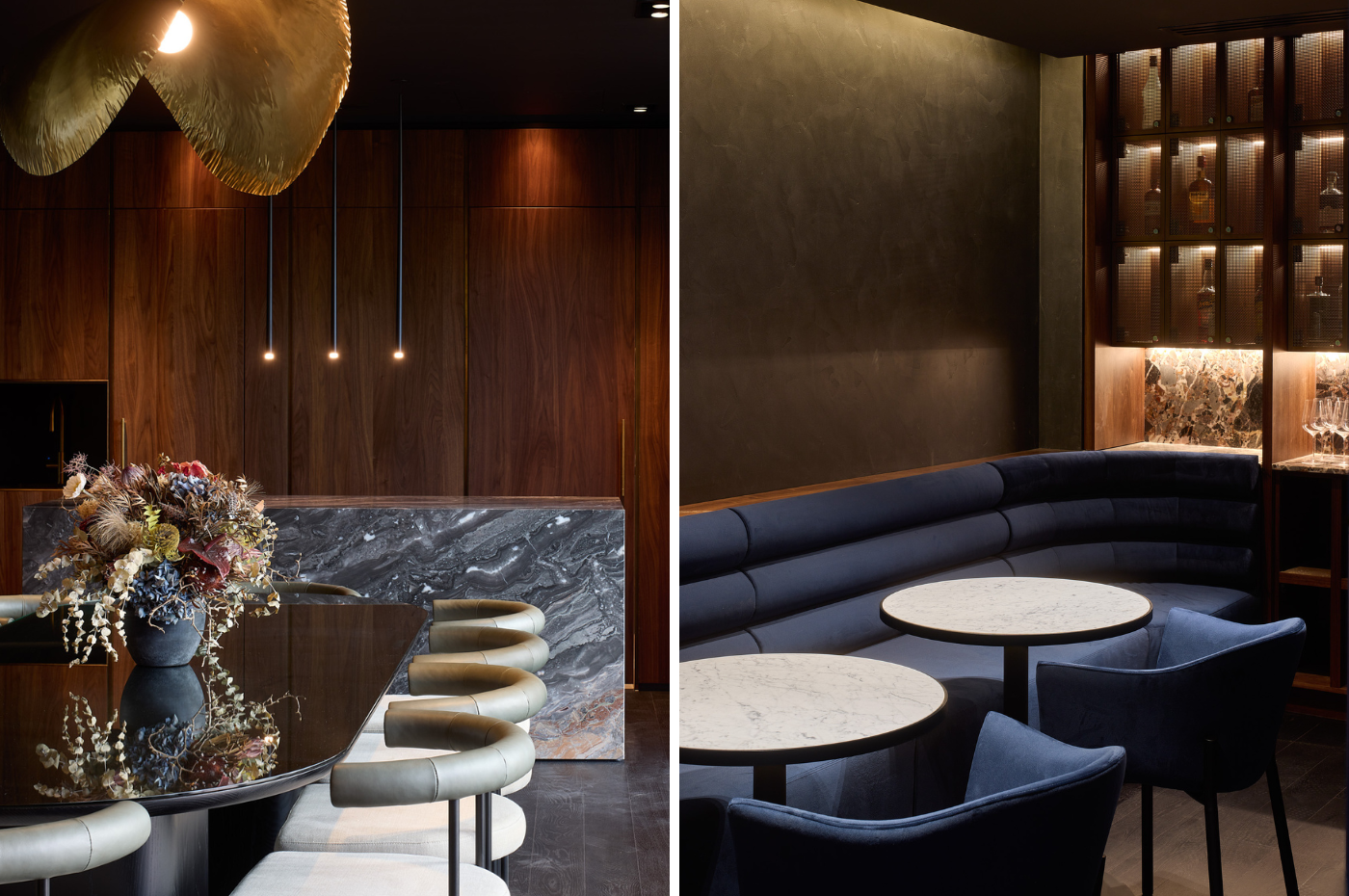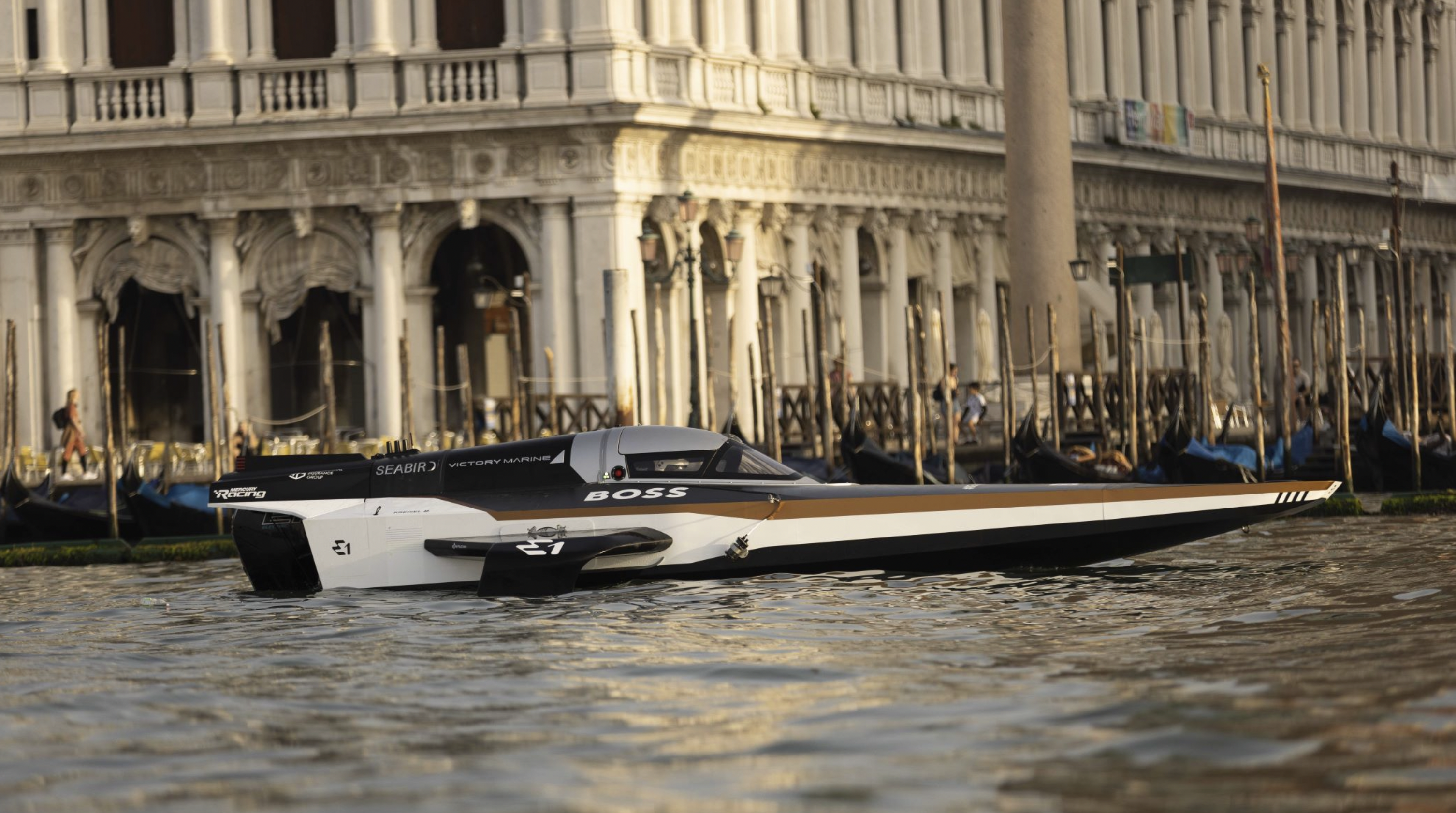
Will Smith, Tom Brady And More Celebs Are Team Owners in a New Electric-Boat League
Will all that star power deliver?
Related articles
At one point during the debut broadcast of the world’s first electric-boat racing circuit, an on-air host stands on a platform overlooking the water and pummels the camera with enthusiasm: “I hope you’re ready for a landmark moment that can change the future of water transportation. The nerves, the excitement, the energy, it’s electric!” Behind her, a few dozen people mill about, leaning on a rail, drinking coffee, staring at their phones. One turns to look at her as if he’d like to ask her to keep it down.
That singular image might best encapsulate the cognitive dissonance that permeates the new UIM E1 Series Championship.
Take the boats. They look like remnants from a Star Wars movie, with long tapered noses leading to a glass-enclosed cockpit flanked on each side by a curving wing that acts as a hydrofoil, allowing the hulls fly over the surface while sending off huge sprays of white foam—but they’re nearly silent and, while they have explosive acceleration, they reach a top speed that wouldn’t even merit a ticket on an interstate.
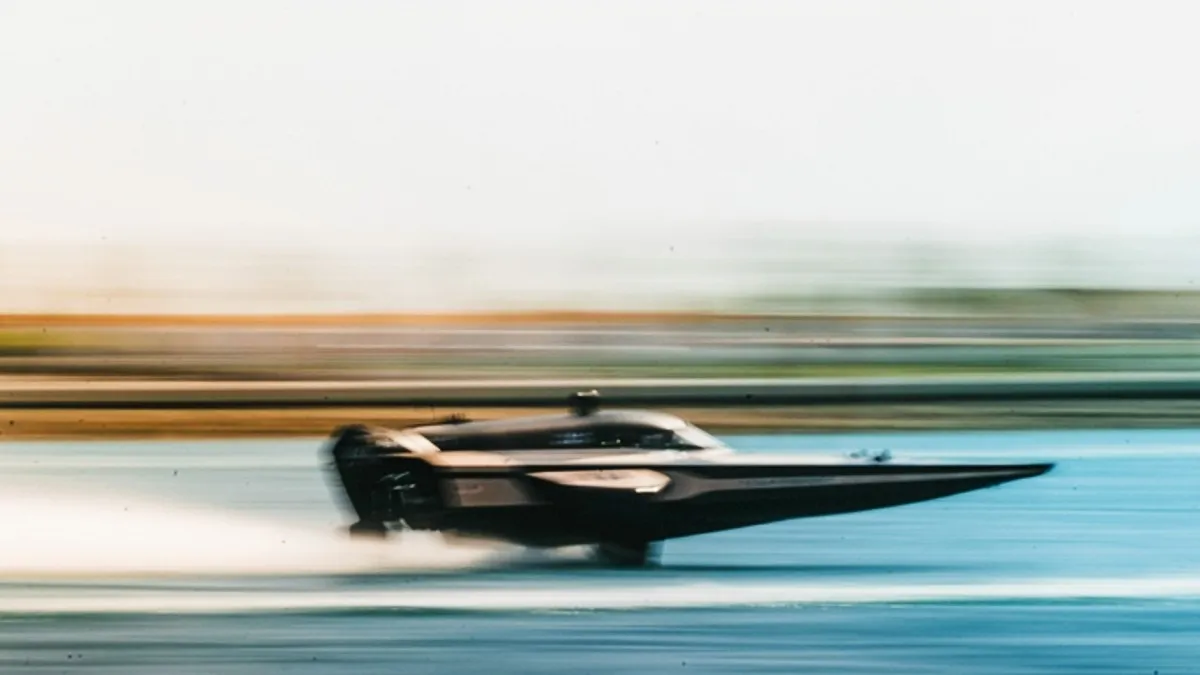
E1 RACING
Then there are the team owners, a mélange of famous people who don’t necessarily bring to mind boats or racing. For that matter, they don’t really have anything to do with one another. Sorry, but it’s going to take more than a few brief hype videos and a recorded Zoom call in which the eight celebrities playfully talk trash before anyone believes the relationship between, say, NFL legend Tom Brady and pop singer Marc Anthony contains any real competitive juice.
There’s also the meeting of mission and money. The series defines itself as “committed to healing our coastal waters and ecosystems . . . through innovative clean technologies and aquatic regeneration.” But Saudi Arabia’s Public Investment Fund (PIF), which controls more than $USD700 billion in cash largely derived from oil production, holds a chunk of equity and occupies the top sponsorship space. (Disclosure: Saudi Arabia’s Research and Media Group has invested in Penske Media Corporation, Robb Report‘s parent company).
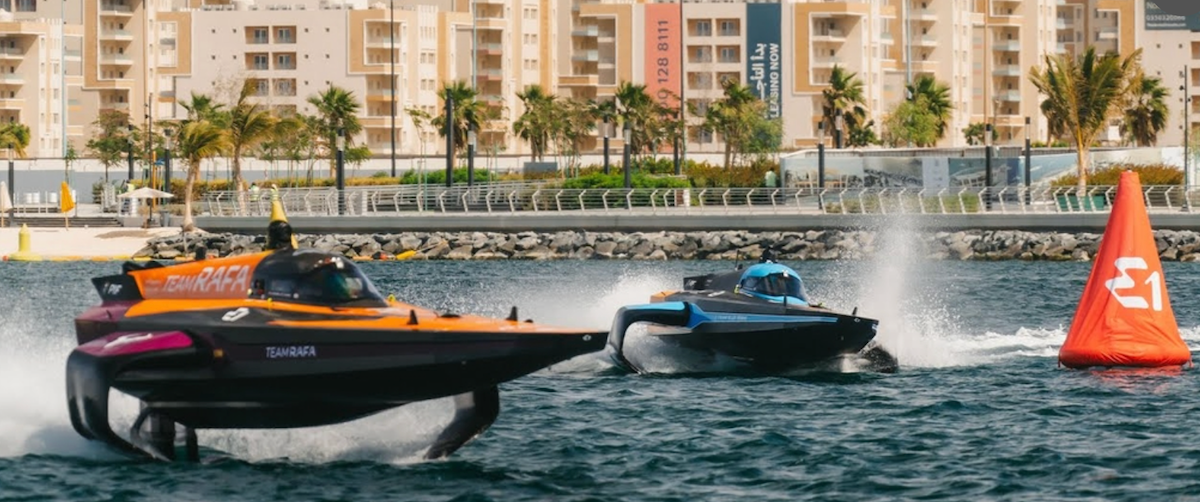
E1 RACING
None of it quite seems to go together, and yet, by many measures that first race, held on an inlet of the Red Sea in Jeddah on Feb. 3, was a success. Expect a ninth team headed by a famous Hollywood actor. The series will host seven more races this year, starting on the waterways of Venice on May 12.
All of which raises the question: Can this actually work?
“Boat racing has never really caught on,” admits Powerboat P1 CEO Azam Rangoonwala, who’s been in offshore racing for more than 20 years and is also a principal on E1’s Team Aoki. “We got involved with E1 because we see an opportunity to finally make that breakthrough happen.”
In 2020, Rodi Basso spent a fair part of the year trying to visualise life after the pandemic. Unlike many others, Basso wasn’t so much longing for the way things had been, as attempting to conjure what new world would emerge.
An aerospace engineer who’d transitioned into motorsports, he’d held jobs at Ferrari, Red Bull and McLaren Applied Technologies, but he’d recently stepped aside and moved to England in pursuit of some then-undetermined new challenge.
When the world shut down, he started running to stay fit and get out of the house, excursions on which he was often joined by Alejandro Agag, who lived nearby. Agag had founded Formula E and Extreme E, each a successful racing series featuring electric vehicles. The pair had met when Basso, through McLaren, developed an improved battery pack that allowed Formula E drivers to complete a race on a single charge.
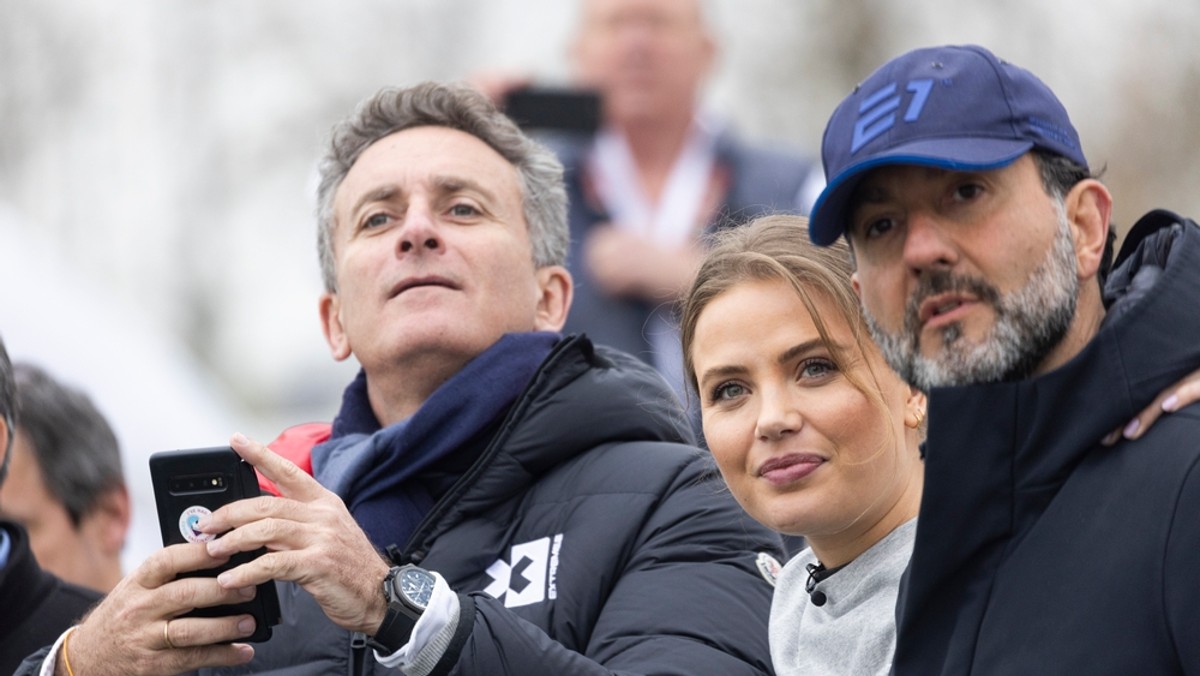
E1 RACING
Basso, an Italian, and Agag, from Spain, debated the next big thing as they traversed the streets of London. Agag had invested in a start-up, Seabird, that was working on a foiling electric boat, and he asked Basso to help with the engineering. That simple request quickly morphed into a new idea—an electric boat racing series.
Perhaps no two individuals were better positioned to make it happen, and that night Basso created a deck summarizing the concept. The next day, he sent it to Agag who immediately signed on. The E1 World Championship Racing series was born amid expectations that it would become the next trending motorsports entity.
Within months they’d secured exclusive rights to stage electric boat races for 25 years through UIM, the international racing organization, and landed the PIF deal. Asked about the irony of Saudi oil money underwriting a series with a mission of “promoting sustainable energy use in marine sports,” and about assertions of greenwashing and sportswashing, Basso looked away from his computer screen.
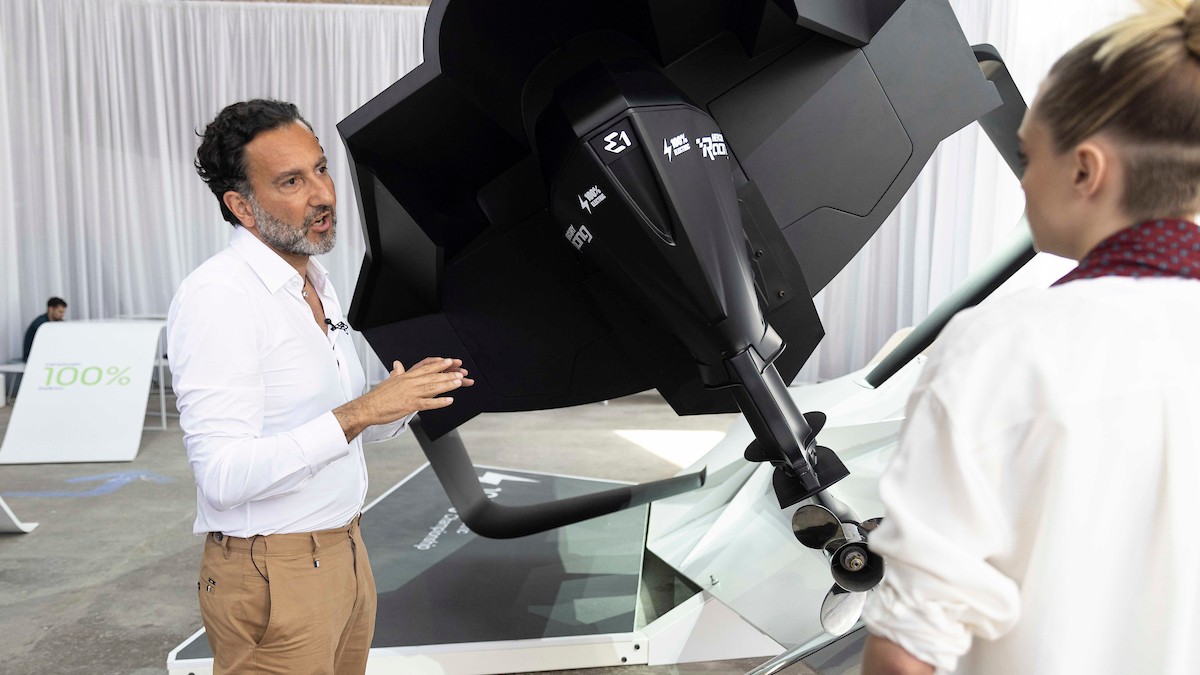
Turning back, he offered a joke and then framed his answer in terms of investing strategies: “I focus on the day-to-day job of the people working at PIF who study markets and industries and place bets on what will bring the highest return. In that sense, it’s a privilege to be noticed and have that initial funding.”
Asked a similar question via email, Brady chooses not to respond, but otherwise replies: “This is a new competition and it has great growth potential, so it was a no-brainer for me to be involved with E1.”
Basso later adds another point: “PIF’s money allowed us to get going. It paid for the development of the boat and the series. Now we have to stand on our own as a functioning business.”
What will that look like?
Location, location, location. Part of the difficulty for boat racing has been the “where.” Contests usually took place offshore or on small—often remote—lakes that offered flat calm, neither of which are particularly spectator friendly.
In recent years, the Sail GP series has solved that problem with a global race circuit featuring smaller, more maneuverable versions of full America’s Cup boats slugging it out on metropolitan waterways, such as San Francisco Bay and Sydney Harbor. In contrast to traditional America’s Cup racing yachts, the smaller SailGP boats also reduce the costs of building, maintaining, outfitting, and shipping them to races around the world.
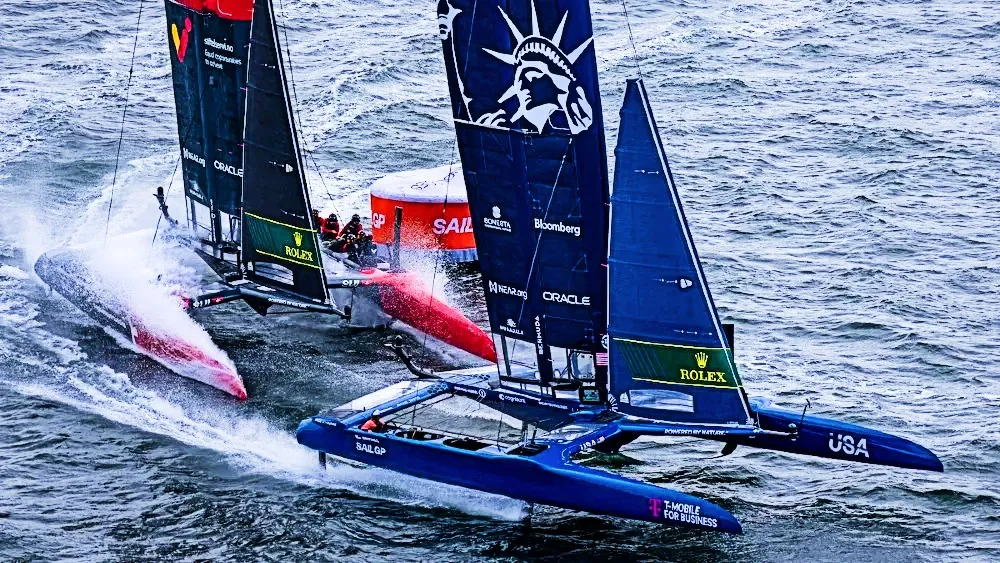
SAILGP
Besides that, the boat looks sleek, part spaceship, part waterbug, as it skitters above the surface. And while 50 knots (92.5 kmph) on a boat is fast—especially an open boat low to the water—it’s not an attention-getting number to the general public. Still, the Racebirds distinguish themselves with a burst of acceleration that’s visible when they compete.
The power comes from a Mercury outboard built specifically for the purpose, with input from Seabird. It has a booster that jacks the output from 100 kilowatts to 150 for 20 seconds per minute, adding to the notable jumps in speed and putting a focus on driver skill and strategy. Each team has two pilots—as they’re called—one male and one female, who alternate turns behind the wheel through a qualifying round, the semi-finals and finals.
“We’re now packaging the propulsion system to sell to other builders,” says Horne. “What drives me is the mission to electrify boats, so we want to partner with other companies out there and help build the infrastructure with fast charging that we’ll need.”
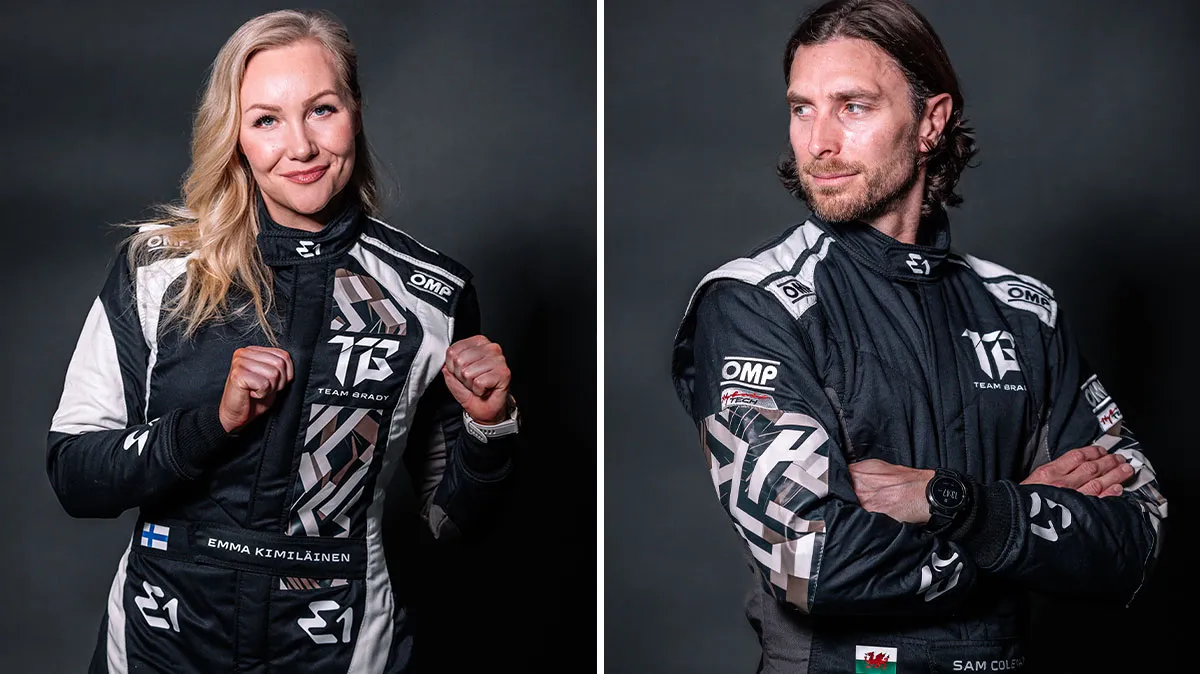
E1 RACING
The series’s green agenda goes beyond pushing the development of electric engines, high-output batteries and hydrofoils, which reduce drag in increase efficiency by lifting the boat’s hull out of the water. E1 intends to employ sustainable practices on-site at events—including the use of local vendors—and install and leave in place high-speed electric charging stations at each locale.
According to its website, organizers will collaborate on coastal restoration projects and education initiatives directed by chief scientist Carlos Duarte, an ocean ecology professor at King Abdullah University of Science and Technology.
“One of the barriers to ownership and sponsorship in powerboat racing has been the sustainability question,” says Rangoonwala of Powerboat P1. “E1 answers that question up front by building it into the mission.”
Whatever seeming contradictions arise from the use of PIF funds, the series has already had a real-world impact. Mercury Marine has incorporated much of the technology it developed for the Racebird engines into its Avator electric outboards. More than 12,000 Avators have been built in the last year. “Racebird was a good place for us to start,” David Foulkes, CEO of Brunswick Corp., Mercury’s parent, tells Robb Report. “It was a way to gain experience in a controlled environment, where the boats are centrally maintained.”
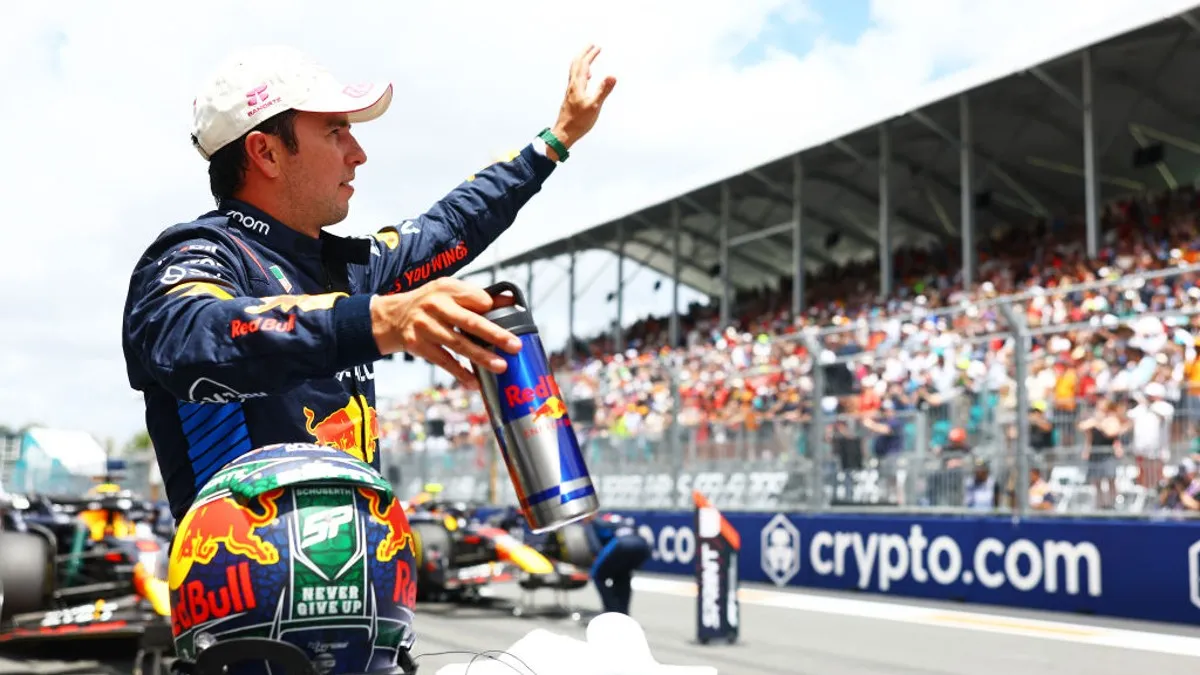
GETTY IMAGES
Basso calls Agag a “marketing genius” for the way he tapped into existing audiences for Formula E and Extreme E by luring well-known names from Formula 1 and extreme racing—and their social media followings—into the fold. It’s a proven approach, but one that would not work for E1. “Unfortunately, in powerboat racing, there are no star drivers or famous owners,” Basso says.
The alternative involved finding celebrities from other walks of life to invest in teams. “First, we approached Sergio Perez and evidently our presentation was done right because he joined, then Rafa Nadal signed up,” Basso says. “The rest came as a consequence of a sort of missing-out syndrome, which worked out nicely for us.”
The sell might have been easy, but the selections reflect the sort of calculated demographic cross-section that would make a pollster drool. Besides Brady, the white American hero of seven Super Bowls, Smith, the Black Hollywood superstar, Nadal, the internationally known Spanish tennis star, Anthony, the Grammy-winning musician with Latino roots, and Perez, a Formula 1 driver from Mexico, there’s Didier Drogba, a Black European soccer icon from Ivory Coast; Steve Aoki, a world-renown DJ of Japanese descent; Virat Kohli, a cricket star from India; and Marcelo Claure, a Bolivian tech entrepreneur.
All appear engaged at the outset, sitting for video interviews and promoting the series on social media. Four showed up for the opening race and Brady plans to be in Venice. “I’ve been involved in a few things since retiring but this racing series has been incredible,” Brady tells Robb Report. “I love competition and racing. Seeing the vision of the sport come to life has been very fun and fulfilling.”
Basso says he and Agag intentionally created a “business mechanism that would give owners skin in the game and keep them engaged.” The owners put up €2 million (about $2.15 million) to license a team. E1 owns the series and the boats and handles all the logistics, including transportation, for which they charge teams another €1 million. The buy-in, Basso says, will go up for Year 2, since three of the original eight license holders have already resold them at five times the initial investment.
To ensure those values keep rising, E1 plans to cap the series at 12 or 15 teams competing in 15 races, hopefully by Year 3, with five events in Asia, five in the Mid-East/Europe and five in the West, where potential venues include Miami, Mexico and Brazil.
To help control costs, the boats must run as they come out of the box, and though teams can hire as many engineers as they want back at headquarters, they can’t have more than seven crew members, including drivers, on the dock during races.
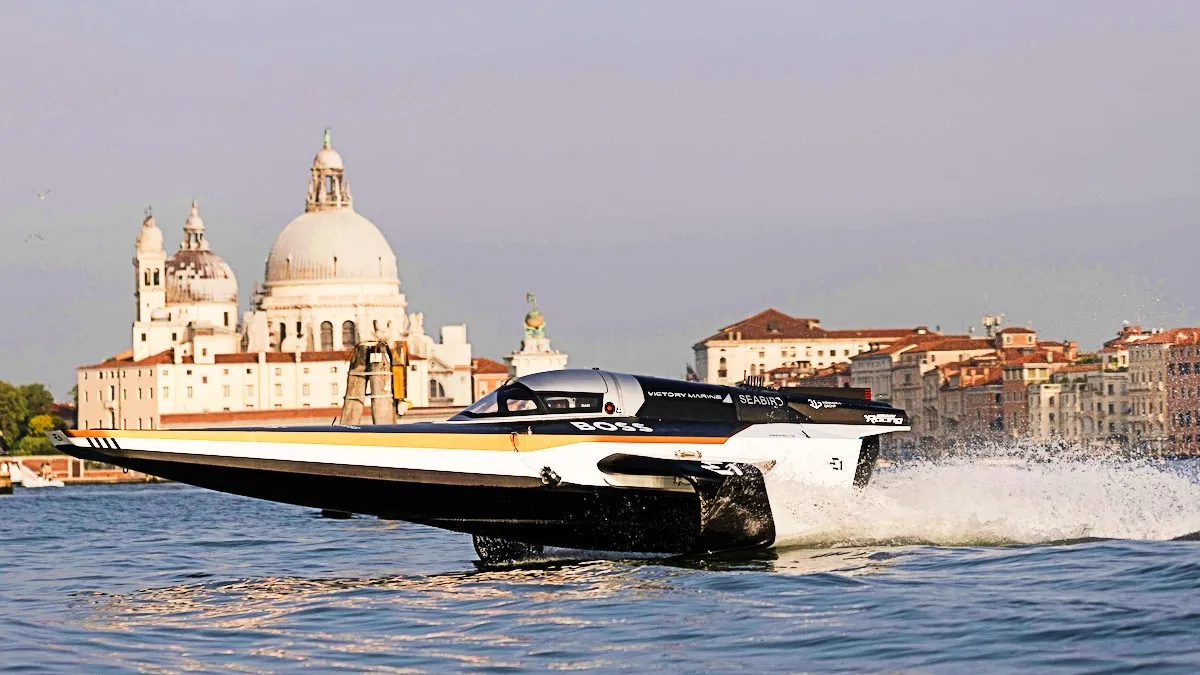
MERCURY MARINE
“They made some really smart decisions to limit costs at the outset,” says Ben King, one of of Team Brady’s co-principals. “The plan is to start modifying the boats in Year 3, which would mean greater outlays for teams, but by then, hopefully, the circuit will be well established.”
Teams can bring on sponsors outside those attached to the wider series, including everything from patches on pilot uniforms to on-the-boat decals to partnerships that showcase technology. Visibility shouldn’t be a problem. E1 has both linear and streaming deals with 120 broadcasters that range from Asia through India, MENA, Europe, and the Americas, where CBS owns the US television rights.
On the course at Jeddah, the four finalists line up for the rolling start of the final race, among them Team Brady. As the boats pass the marker buoy signaling the beginning of the first-ever E1 championship, three surge ahead while the Brady boat founders and wobbles forward, dropping to last.
In the previous heat, Brady’s Emma Kimiläinen finished third, meaning teammate Sam Coleman has to not just win the heat but make up the time deficit to claim the title. As the boats approach the first turn, Coleman mashes the booster and jolts forward, closing the gap and creating a three-boat bottleneck around the first buoy.
The scene turns chaotic as the boats speed through the curve within yards of each other and geysers of whitewater and churning wakes fill the space around them. Emerging into the straight, they jockey for the lead. “Racing these boats is super intense—insane,” says Coleman. “The trick is constantly managing the foil height. Too much power and the boat will drop and you’ll lose speed. The working window is so small, and while you don’t have engine noise, there’s feedback through cavitation and vibration that you have to learn to feel.”
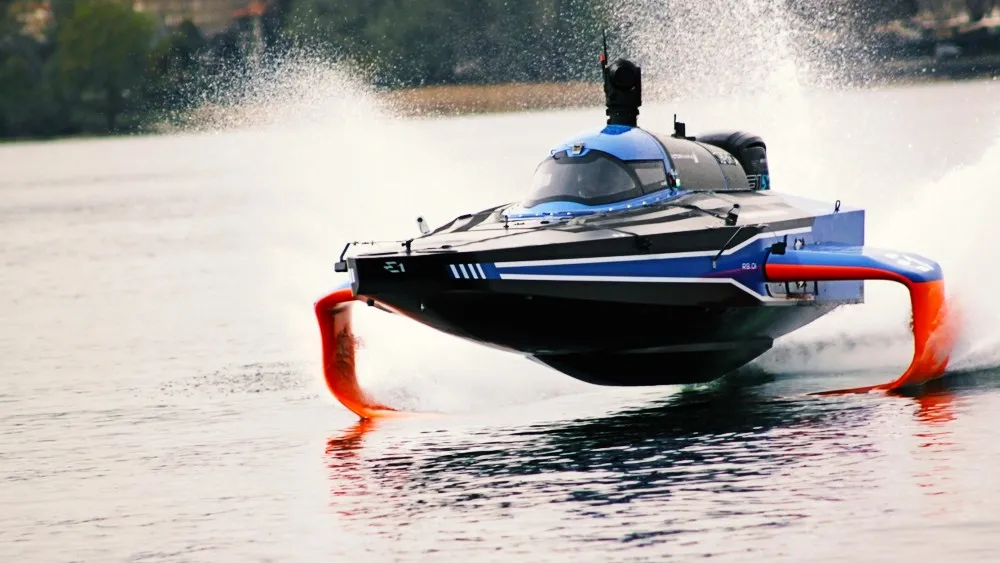
E1 RACING
Most of the drivers have come from other disciplines, motorcycles, cars, even Jet Skis and WaveRunners. Coleman started in motocross, then teamed with his sister to become a world champion and two-time U.K. champ in P1 Powerboat. Whether it’s that experience or his feel for his craft, Coleman’s boat levels and rises high on its foils as it shoots to the front.
Through the next turns, Coleman’s lead builds, creating another bit of intrigue. The course layout consists of a small oval inside a larger one, something like a paperclip. Over a five-lap race, each driver must circumnavigate the inner oval four times and the outer once. As Coleman continues to pull away, the question of when to take the long lap rises.
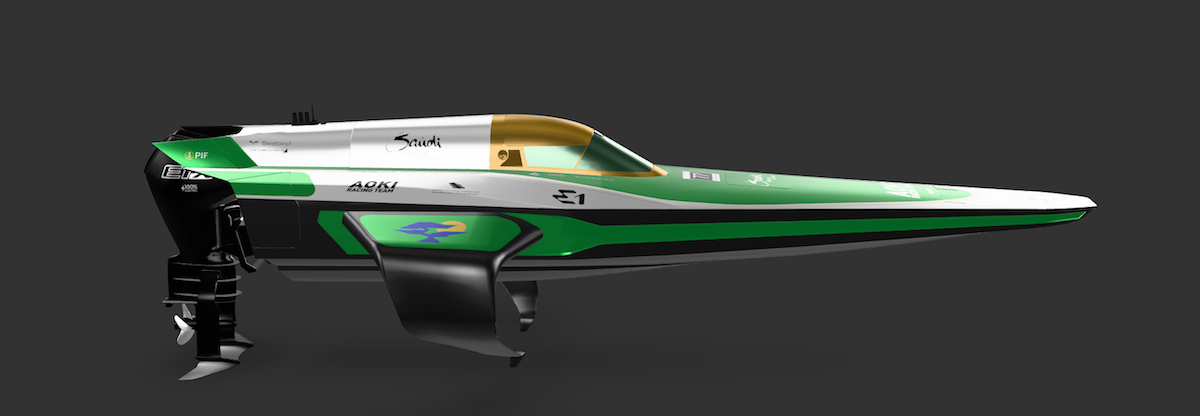
E1 RACING
And while that gives the announcers something to talk about, it also highlights a shortcoming. The moments of close-quarters racing, the nuance of working the trim and booster and the strategic quirk of the long lap all make for good, engaging viewing. At the same time, the difficulty of keeping the boats running clean on the foils and the long lap spread the field, sapping most of the drama from the action. Those instances of intense, close-quarters racing are few and far between.
Ultimately, that’s what success will come down to: Will people understand the level of skill and strategy on display and will the competition hold up? A sustainability mission and a few 30-second hype videos from Tom Brady (whose team pulled through in Jeddah as the winner) provide a sense of purpose and attract eyeballs, but for people to continually show up and tune in—to pay up—the races themselves have to deliver.
Formula E and Extreme have made it work. Will E1? Ladies and gentlemen, start your very-quiet engines.
Subscribe to the Newsletter
Recommended for you
This New Mercedes-Benz All-Electric Concept Is a Bonkers Ode to Art Deco
The rakish EV’s look is inspired by the marque’s pre-war coupes.
By Bryan Hood
October 23, 2025
The 12 Most Exciting Yachts at This Year’s Monaco Show
With launches ranging from a 30-metre Lamborghini cruiser to Giorgio Armani’s last design, this year did not disappoint.
By Julia Zaltsman, Michael Verdon
October 9, 2025
You may also like.
You may also like.
Radek Sali’s Wellspring of Youth
The wellness entrepreneur on why longevity isn’t a luxury—yet—and how the science of living well became Australia’s next great export.
Australian wellness pioneer Radek Sali is bringing his bold vision for longevity and human performance to the Gold Coast this weekend with Wanderlust Wellspring—a two-day summit running 25-26 October 2025 at the RACV Royal Pines Resort in Benowa. Sali, former CEO of Swisse and now co-founder of the event and investment firm Light Warrior, has long been at the intersection of wellness, business and conscious purpose.
Wellspring promises a packed agenda of global thought leaders in biohacking and longevity, including Sydney-born Harvard researcher David Sinclair, resilience pioneer Wim Hof, performance innovator Dave Asprey and muscle-health expert Gabrielle Lyon. From immersive workshops to diagnostics, tech showcases, and movement classes, Sali aims to make longevity less a niche pursuit for the elite and more an accessible cultural shift for all. Robb Report ANZ recently interviewed him for our Longevity feature. Here is an edited version of the conversation.
You’ve helped bring Wellspring to life at a moment when longevity seems to be dominating the cultural conversation. What drew you personally to this space?
I’ve always been passionate about wellness, and the language and refinement around how we achieve it are improving every day. Twenty years ago, when I was CEO of Swisse, a conference like this wouldn’t have had traction. Today, people’s interest in health and their thirst for knowledge continue to expand. What excites me is that wellness has moved into the realm of entertainment—people want to feel better, and that’s something I’ve always been happy to deliver.
There are wellness retreats, biohacking clinics, medical conferences everywhere. What makes Wellspring different?
Accessibility. A wellness retreat can be exclusive, but Wellspring democratises the experience. Tickets start at just $79, with options up to $1,800 for a platinum weekend pass. That means anyone can learn from the latest thought leaders. Too often in this space, barriers are put up that limit who can benefit from the science of biohacking. We want Wellspring to be for everyone.
You’re not just an organiser, but also an investor and participant in this field. How do you reconcile passion with commercial opportunity?
Any investment I make has to have purpose. Helping people optimise their health has driven me for two decades. It’s satisfying not just as an investor but as an operator—it builds wonderful culture within organisations and makes a real difference to people’s lives. That’s the natural fit for me, and something I want to keep refining.
What signals do you look for in longevity ventures to separate lasting impact from passing fads?
A lot of what we’re seeing now are actually old ideas resurfacing, supported by deeper scientific research. My father was one of the first in conventional medicine to talk about diet causing disease and meditation supporting mental health back in the 1970s. He was dismissed at first, but decades later, his work was validated. That experience taught me to look for evidence-based practices that endure. Today, we’re at a point where great scientists and doctors can headline events like Wellspring—that’s a huge cultural shift.
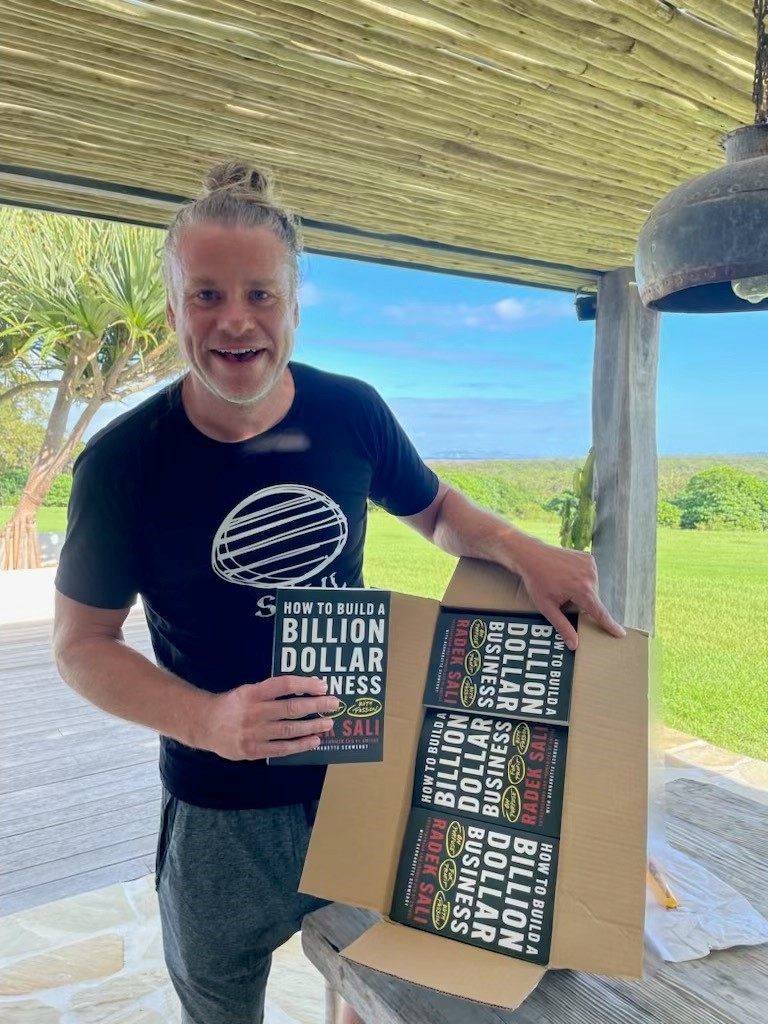
Longevity now carries a certain cultural cachet—its own insider language and status markers. How important is that to moving the field forward?
Health is our most precious asset, and people have always boasted about their routines—whether it’s going to the gym, doing a detox, or training for a marathon. What’s different now is that longevity practices are gaining mainstream recognition. I see it as something to be proud of, and I want to democratise access so everyone can ride the biohacking wave.
But some argue that for the ultra-wealthy, peak health has become a kind of luxury asset—like a private jet or a competitive edge.
That’s short-sighted. Yes, there are extremes, but most biohacking methods are accessible and inexpensive. Look at the blue zones—their lifestyle practices aren’t costly, yet they lead to long, healthy lives. That’s essential knowledge we should be sharing widely, and Wellspring is designed to do that in an engaging way.
Community is often cited as a key factor in healthspan. How does Wellspring foster that?
Community is at the heart of it. Just as Okinawa thrives on social connection, we want Wellspring to be a regular gathering place where people uplift each other. Ideally, it would become as busy as a Live Nation schedule—but for health and wellness.
Do you worry longevity could deepen class divides?
Class divides exist, and health isn’t immune. But in Australia, we’re fortunate—democracy and a strong equalisation process help maintain quality of life for most. Proactive healthcare, like supplementation and lifestyle changes, isn’t expensive. In fact, it’s cheaper than a daily coffee. That’s why we’re one of the top five longest-living nations. The opportunity is to keep improving by making proactive health accessible to everyone.
Some longevity ventures are described as “hedge-fund moonshots.” Others, like Wellspring, seem grounded in time-tested approaches. Where do you stand?
There’s value in both, but I’m more interested in sensible, sustainable practices. Things like exercise, meditation, and community-driven activities are proven to extend life and improve wellbeing. Technology can support this, but we can’t lose sight of the human elements—connection, balance, and purpose.
Finally, what role can Australia—and Wellspring—play in shaping the global longevity conversation?
The fact that we can put on an event like Wellspring, attract world-leading talent, and already have commitments for future years says a lot. Australia is far away, but that hasn’t stopped great scientists and thinkers from coming. We’ll be here every year, contributing to the global conversation and, hopefully, helping more people extend their healthspan.
You may also like.
‘Continuum’ Opens to Rave Applause at Sydney Dance Company
Rafael Bonachela’s latest curatorial triumph premiered last night at the Roslyn Packer Theatre, dazzling audiences with its emotional range and fearless physicality.
Sydney Dance Company opened its latest season with Continuum, a triple bill that reminds audiences why the ensemble remains Australia’s most compelling cultural export. Receiving a standing ovation at its premiere last night at the Roslyn Packer Theatre, the program unfolds as an elegant meditation on movement and metamorphosis—three distinct choreographic visions held together by Rafael Bonachela’s curatorial precision and instinct for contrast.
Stephen Page’s Unungkati Yantatja – one with the other breathes land, sea, and sky into motion; Tra Mi Dinh’s Somewhere between ten and fourteen lingers in the tender light between day and night; and Bonachela’s own world-premiere Spell delivers the evening’s visceral heartbeat. Together they trace the continuum of life itself—fluid, volatile, and impossible to pin down. Running through 1 November, the production affirms Bonachela’s vision of dance as “an ever-evolving conversation between artists, audiences, and the world around them.” Robb Report ANZ recently caught up with Bonachela.
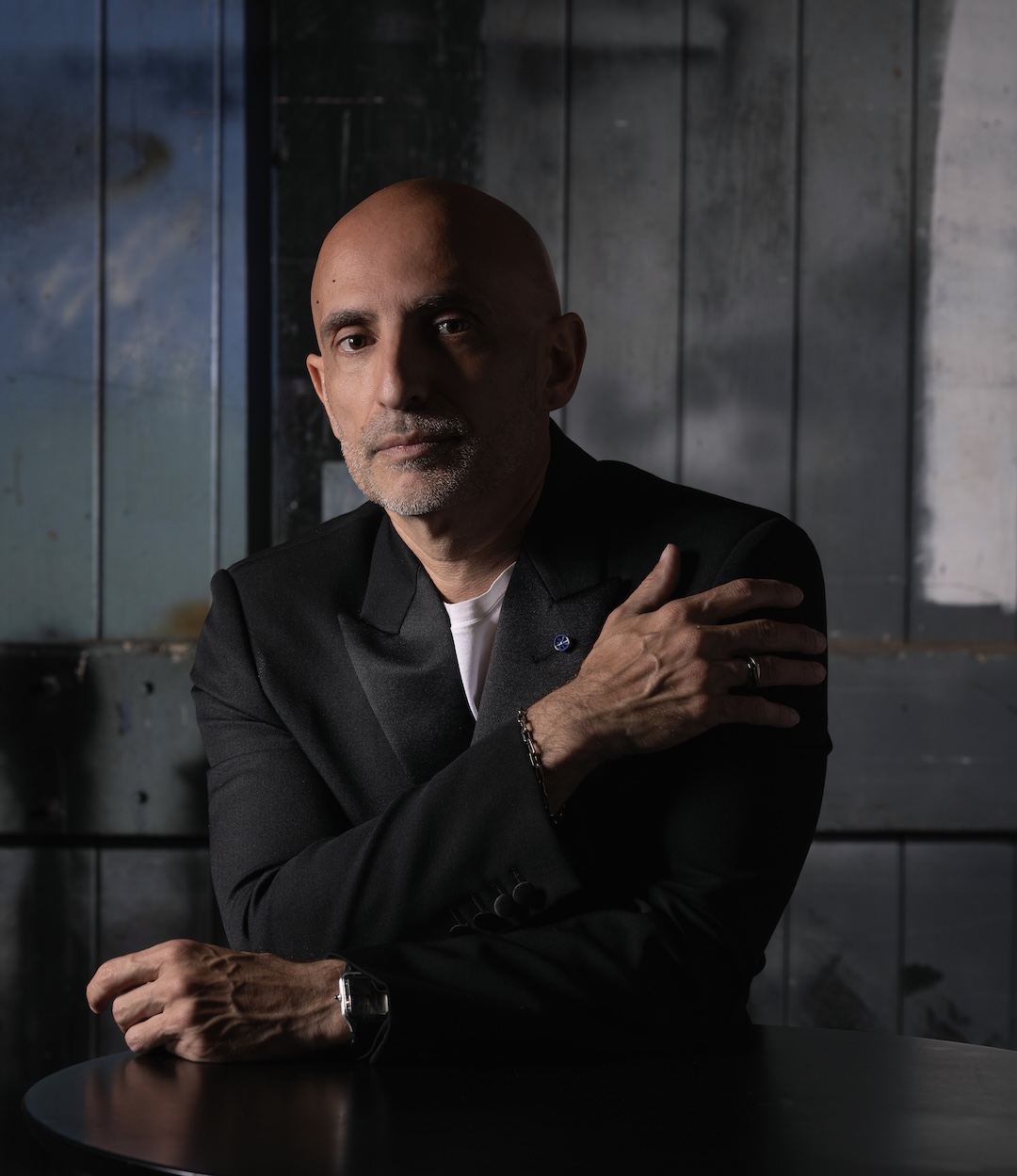
Continuum is described as “a bold exploration of the ever-shifting cadence that binds us to the world.” How did this idea of constant transformation influence your choreographic choices in Continuum?
I’ve curated this evening as an invitation for audiences to experience dance as an ever-evolving conversation—between past and present, between the individual and the collective, and between diverse artistic voices. My intention with this program is to spark connection, curiosity, and reflection, offering works that challenge, move, and inspire while revealing the transformative power of the body in motion.
Each choreographer brings a distinct perspective, yet all share a commitment to exploring the body in motion as a vessel for transformation. Through contrasting aesthetics, cultural resonances, and shifts in time, these works reveal how dance exists on a continuum—where moments build upon one another, find new meanings in fresh contexts, and affirm the enduring power of the human form to express what words cannot.
You’ve created the world premiere Spell within Continuum, which explores “the limits of emotional and physical expression.” What did you aim to conjure emotionally and physically through Spell, and how does it dialogue with the other works in the triple bill?
The title Spell itself suggests a duality—it can be something magical, but also something we fall under without even realising. Emotionally, I want to evoke an atmosphere that is at once intimate and volatile, where vulnerability and power exist side by side. There’s a ritualistic quality to the work, as if the dancers are caught inside a force they cannot quite escape—and it’s that tension which drives the movement and fuels the piece.
Within Continuum, Spell emerges as an intense, visceral heart—both contrasting with and speaking to the other works. While it shares the evening’s theme of transformation, it explores it through a lens of emotional ignition and fearless physicality.
In crafting Continuum, how did you balance moments of intimacy and expansiveness—especially when layering live elements like music and immersive lighting—to evoke that ebb and flow of life’s narratives?
In Continuum, each choreographer works with complete artistic freedom, without any direction from me. That independence brings out authentic contrasts and unexpected connections between the works. It’s this variety that invites audiences to engage on their own terms, discovering personal meanings and emotional threads that are unique to each viewer.
This triple bill seems to offer a journey through time and place—from twilight’s fleeting beauty to elemental breath. How do you want audiences to experience—and perhaps rethink—the relationship between movement, nature, and storytelling?
I always want audiences to come with an open mind and allow the experience to be unprescribed free to discover their own meanings and narratives. Dance has the unique power to be felt as much as it is seen, to resonate physically and emotionally in ways words can’t. I hope audiences leave with a renewed sense of how deeply movement is connected to the natural world, and how it can tell stories without language. Like nature, this evening is always in motion—emerging, transforming, and fading—so that each work becomes a landscape the audience can journey through, sensing their own place in the continuum of life
Looking ahead, does Continuum carve out a new direction or personal milestone for your artistic trajectory? What might this signal for your future choreographic explorations?
Continuum feels like both a culmination and a starting point. It gathers threads from my past work, my fascination with transformation, my love of collaboration, my search for emotional truth and weaves them into something that opens new doors.
Creating and curating this triple bill has changed how I see works interacting—how contrasting voices can strengthen shared themes. It’s inspired me to explore even more fluid boundaries between ideas, styles, and disciplines.
If it signals anything for the future, it’s that I’m interested in going further into that space where dance is not just movement, but an ongoing conversation—between artists, between forms, and between audiences and the world around them.
Continuum runs through November 1 at the Roslyn Packer Theatre.
You may also like.
Inside the $30 Billion Obsession Among the Ultra-Wealthy : A Race to Live Longer
The pursuit of an extended life has become a new asset class for those who already own the jets, the vineyards, and the art collections. The only precious resource left to conquer, it seems, is time.
If you want to know what the latest obsession is these days among the ultra-wealthy, listen in at dinner.
Once it was crypto, then came AI and psychedelics, now it’s longevity all the time. The talk is of biomarkers, NAD+ levels, and methylation clocks, of senolytics and stem cells. Guests compare blood panels like wine lists, and the most important name to drop is no longer your banker or contact at Rolex but your longevity physician. For those just arriving at the conversation, the new science can sound like science fiction—but it’s fast becoming the lingua franca of money.
The field has its own vocabulary—epigenetic reprogramming, which aims to reset cellular clocks; cellular senescence clearance, the removal of “zombie” cells that clog our systems as we age; precision gene therapies, designed to personalise interventions at the level of DNA—that sounds equal parts Brave New World and Wall Street pitch deck. But make no mistake: this is no longer a niche pursuit. The sector is already worth an estimated $30 billion globally and projected to surpass $120 billion within the decade, having attracted billions in investment from the likes of Altos Labs, Juvenescence and Google-backed Calico. Tech titans and old-money families alike are staking claims on the possibility of an extra decade or two. It’s a space where venture funds court Nobel laureates, hedge funds bankroll gene-therapy moonshots, and even wellness festivals in Australia draw rock-star scientists to the stage.
The Poster Child and the Pitch
David Sinclair, the Sydney-born Harvard geneticist who has become something of a poster child for the field, is quick to underline the stakes. “We’re not just talking about lifespan, we’re talking about health span,” he tells Robb Report. “Extending the number of years people live well—without frailty, without disease—isn’t just a medical breakthrough. It’s a social and economic one.” Sinclair, whose research ranges from NAD boosters to epigenetic age-reversal therapies, has calculated that adding a single year of healthy life to the US population, for example, could be worth $38 trillion in economic benefit—fewer years of costly aged care, less burden on hospitals, more years of productivity and compounding returns. In other words, the dividends of health are financial as well as personal. “That’s why governments and investors are paying attention,” he says.
Sinclair has become a fixture on the global circuit, drawing crowds that rival TED or Davos. As Radek Sali, the Australian entrepreneur behind the new Wanderlust Wellspring longevity festival taking place on the Gold Coast this October, where Sinclair is the keynote speaker, puts it: “Wellness has moved into the realm of entertainment.” At Wellspring, platinum-tier guests pay up to nearly $2,000 for the privilege of hearing scientists and investors share the stage over a weekend like headliners at Coachella.
Investing in Time
And then there are the sideshows. Bryan Johnson, the tech mogul turned human guinea pig, makes headlines with his open-source, organ-by-organ data tracking—his infamous “penis readings” have become cocktail-party fodder. While many dismiss him as a parody of the field, his multimillion-dollar project Blueprint has nevertheless made longevity impossible to ignore in the mainstream.
For the uninitiated, the science of longevity today is no longer about vitamin salesmen or fringe dietary regimes. This is the new frontier—one where biology is not just observed but engineered, and where investors smell opportunity on par with space travel. It’s little wonder that Altos Labs has raised billions to chase cellular rejuvenation, or that Juvenescence has secured more than $400 million to fast-track therapies. What was once the realm of eccentric tinkerers now attracts sovereign wealth funds.
“This body takes me to meetings, earns me money—why not invest time and money into it?”
The appeal to the One Percent is obvious. Longevity is a natural extension of portfolio thinking: diversify your assets, hedge your risks, and above all, maximise return on investment. Except in this case, the returns are measured in years of health, energy and cognition. As Andrew Banks, a Sydney-based entrepreneur and early investor in Juvenescence, explains: “This body takes me to meetings, earns me money—why not invest time and money into it?” His Point Piper home teems with contraptions—a Reoxy breathing machine, hydrogen therapy, red-light sauna, and he spends a few hours a day on maintenance, as if his body were a private equity stake.
Banks, like others in his cohort, is baffled that more wealthy men haven’t followed suit. “Entrepreneurs pride themselves on divergent thinking,” he says. “They expand, dream and create businesses with it. But when it comes to their bodies, they’re convergent—unimaginative. The lack of curiosity is astonishing to me.”
Medicine 3.0 and the New Rituals
Steve Grace, a Sydney-based entrepreneur and the proprietor of exclusive private networking club The Pillars, which is opening a longevity program, thinks there is a reckoning coming for those who do not take matters into their own hands. “As someone who has run a few recruitment businesses,” he says, “I can tell you that if you’re a man or woman in your 50s and working as an employee, even in a really good position, it’s time to get worried about job security and being aged out of the workforce. You have to make yourself as vital as possible and become the best version of yourself, or you’re toast.”
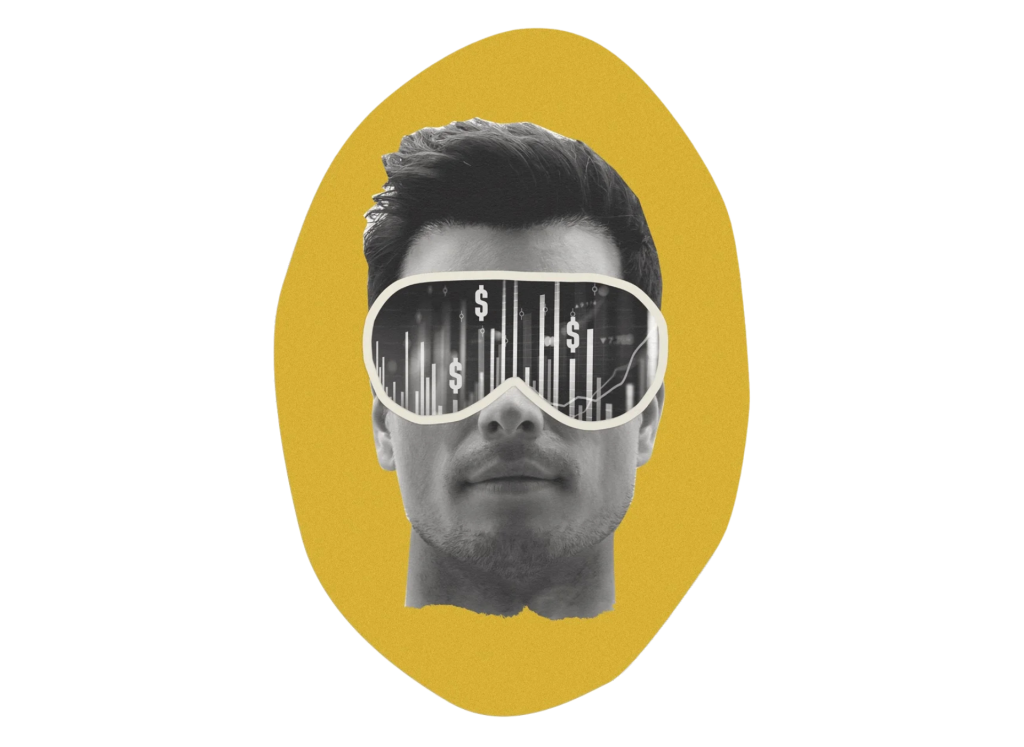
What was once fringe has now become a cultural necessity for those who can afford anything, with science finally catching up to ambition. Sinclair’s lab at Harvard recently published a study on the reversibility of cellular ageing—restoring vision in blind mice and setting the stage for human trials in conditions like glaucoma. In Boston, his company Life Biosciences will begin treating patients with blindness in a Phase I trial using partial cellular reprogramming early next year. “This isn’t science fiction anymore,” Sinclair says. “We’re at the point where we can reprogram cells, turn back their biological clocks, and restore function.”
Meanwhile, practitioners like Dr. Adam Brown of the Longevity Institute in the Sydney suburb of Double Bay are reinventing diagnostics. His “assessment menu” has been compared—only half-jokingly—to a Michelin Guide for medical testing: full-body MRI scans, continuous glucose monitors, polygenic risk scores. “What we do is proactive, not reactive,” he says. “Correct deficiencies first, then optimise health. That’s how you get peak performance in the short term and resilience in the long term.” Brown frames longevity in terms that would resonate with any investor: “There’s a short-term ROI—fixing glucose or sleep issues so you perform better tomorrow. And there’s a long-term ROI—functioning in your 70s as you would in your 40s. That’s extending your career, your income potential and your independence.”
“Once upon a time, male vanity meant injectables, veneers and a tan. Today, it’s VO2 max scores and continuous glucose monitor readouts.”
Peter Attia, the Canadian-American physician and podcast host who has helped popularise the concept of “Medicine 3.0”, echoes this emphasis. Medicine 1.0, according to him, was about surviving infections. Medicine 2.0 was about treating chronic disease. Medicine 3.0 is about staying ahead of decline: measuring, monitoring and intervening early. “The goal is not just to avoid disease but to lengthen health span,” Attia has said.
For those already converted, longevity is less about lab science than daily rituals. Sydney-based Chief Brabon, who trains CEOs like athletes, says: “These men are like Formula One cars—you don’t wait until the tyres are bald before swapping them. You keep everything tuned, precise, optimised.”
That tuning now involves more gadgets than ever: hyperbaric oxygen chambers, cryotherapy, sauna/cold-plunge circuits, peptide stacks, nootropics. And yes, a glut of supplements, some with evidence, others little more than wishful thinking. Once upon a time, male vanity meant injectables, veneers and a tan. Today, it’s VO2 max scores and continuous glucose monitor readouts. “Health is the new flex,” as Steve Grace quipped, glancing at his wrist-worn biometric tracker.
The New Flex: Health as the Ultimate Luxury
Still, there is plenty of scepticism. Some therapies are unproven, others prohibitively expensive. And there is the unavoidable fact that many leading scientists, including Sinclair, have stakes in companies producing supplements and therapeutics, raising eyebrows about conflicts of interest. “The difference,” Sinclair insists, “is whether it’s backed by peer-reviewed science and measurable biomarkers. If it can’t be quantified, it’s marketing, not medicine.”
Then there are the contradictions. It promises democratisation while often priced like a private club. It champions science but thrives on hype. It seeks to extend health span but risks deepening class divides. “Only if we let it,” Sinclair says when asked if longevity risks becoming the preserve of the wealthy. “Like antibiotics or aspirin, these advances should become widely available and affordable once they scale.” Sali agrees, but from another angle: “Biohacking doesn’t have to be expensive,” he says. “The blue zones prove that—community, diet, movement, purpose. Those are free. Wellspring is about making that knowledge accessible.”
And yet, for all its shortcomings, the movement is here to stay. Investment continues to pour in. Technology—like senolytic drugs that clear aged cells or AI-driven platforms that predict individual disease risk years in advance—is moving from speculation to clinical trial. Scientists are being recast as influencers. And the wealthy, always in search of the next advantage, have found in longevity a pursuit as old as alchemy, yet dressed in the language of venture capital. The truth is that health has always been an asset. What’s new is that it’s now being traded, optimised and measured like one.
In the end, longevity is less about a moonshot than about curiosity. Banks, Sali, Sinclair, Attia are all, in their own way, betting on time. Perhaps the most radical idea is also the simplest: that the best-performing asset in any portfolio is the body itself. Unlike Bitcoin, it carries you to meetings. Unlike art, it cannot be stored in a vault. Unlike real estate, it is non-transferable.
The new calculus of longevity is the recognition that the ultimate luxury is not wealth or status, but a few more decades of clear thought, strong bones and good company—and the ability to make money off it. Everything else, as one investor put it, is just a rounding error.
You may also like.
How Sailing Shaped Loro Piana’s Most Iconic Designs
Pier Luigi Loro Piana grew his family textile business into a celebrated fashion house by following his passion for sports on land and at sea.
The Regatta Connection
The race village at Port de Saint-Tropez is awash with people in nautical navy and white, the de facto dress code for the Loro Piana Giraglia regatta. This is the second year the fashion house has lent its name to one of the Mediterranean’s most prestigious summer races. The course zooms from the French coast to Genoa, Italy, taking a sharp turn past Giraglia, a small island off Corsica’s northern tip. It’s the latest in a long line of marine events the brand has sponsored, dating back more than 20 years.
The link between sailing and the brand—and more consequentially the Loro Piana family—is exemplified by the man Robb Report is here to meet: Pier Luigi Loro Piana. An avuncular figure in his 70s with the physique of a man who has enjoyed life, Pier Luigi fell in love with sailing in his late teens, when a family friend took him for a cruise in a sloop.
“Using the wind to go faster or slower, driving the boat like it has an engine, it’s really fascinating,” he says. Inevitably, he started competing. “When you’re sailing, you’re always looking for other boats to go and fight with. It’s an instinct,” he says. And then, with considerable understatement, “I think it’s a nice hobby.”
A Life Under Sail
He currently owns two boats: My Song, which you can see on these pages, is a 25 m sailing yacht that competed in the Regatta. There’s also Masquenada, a comfortable 50 m explorer. It’s a commendable set-up befitting a man who shaped one of Europe’s most celebrated fashion houses.
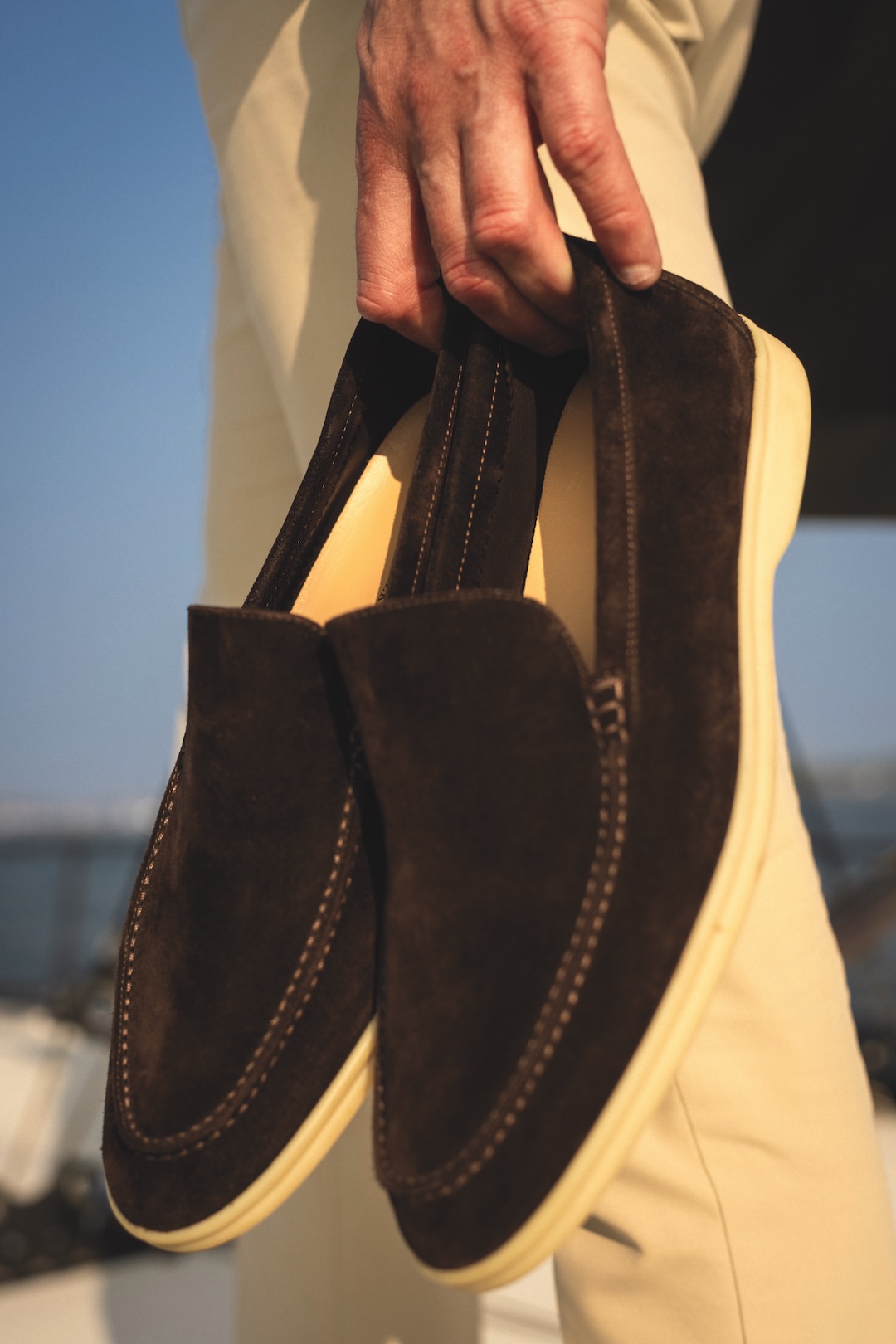
A Family Business Turned Global Powerhouse
The textile and clothing company that bears his family’s name was launched by an ancestor, Pietro Loro Piana, in 1924. A few generations later, Pier Luigi and his brother, Sergio, would run it for four decades until LVMH acquired a majority stake for around $4 billion in 2013. Sergio passed away that year; his widow and Pier Luigi still own a share of the brand between them.
The brothers proved innovative custodians, moving the company upmarket with an insistence on ultra-fine materials and groundbreaking fabrications. And the connection with sports—specifically yachting, horseback riding, skiing and golf—is integral to how the brand positions itself. As Pier Luigi recalls, such associations often had self-serving origins.
“These are the sports my brother and myself were doing,” he says. “We were very committed in business in the 1970s, ’80s, ’90s, so we were like our customers: people that like to work hard but also play hard. And that meant sports.”
Innovation Born of Necessity
This affinity often led them to develop durable, yet elegant, materials and gear for their off-duty pursuits, eventually offering versions to their athletic clientele. “We engineered products with unusual properties, natural fibres like wool or cashmere with a membrane that makes it waterproof and windproof… For research and development, I was the first victim,” he says with a chuckle. Once, he wanted a ski jacket that was “warmer, lighter, softer and better” than nylon models, so he made a prototype to test on the slopes. It gave birth to the Loro Piana Storm System, launched in 1994. The line’s wind-resistant waterproof wool and cashmere has since been used by brands around the world. “I still have this jacket,” he says.
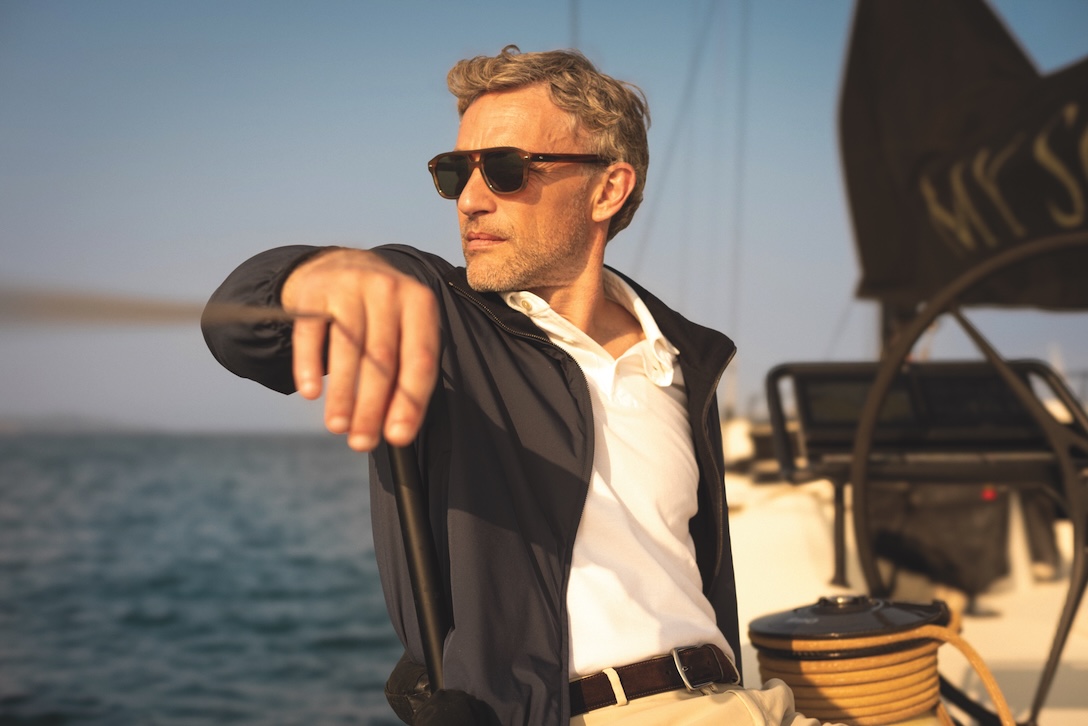
The same process happened on the water. A beloved reversible bomber, with knitted cashmere on one side and waterproof polyester on the other, was born from Pier Luigi’s need for a functional jacket to wear on his yacht. “It’s very light, doesn’t wrinkle, it’s warm, windproof,” he says. “It solves so many problems.”
He takes less credit for perhaps the brand’s most famous—and almost certainly most imitated—product, the white-soled suede Summer Walk loafers. “That was my brother,” he says. “When we were 20, 30 years old, we went sailing and there were only [Sperry] Top-Siders or Sebagos. But when the soles got worn, they got hard and slippery.”
The answer: a non-marking sole with grip—“like a tire you use in Formula 1 when it’s wet”—which Sergio got his bespoke shoemaker to sew to suede uppers. Eventually, they produced two versions: a loafer and the Open Walk, a model with a slightly higher top. “We discovered people were using them also for formal wear because they were so comfortable,” says Pier Luigi. “It’s really a successful story that started from product research.”
And if problem-solving can turn your family business into a giant of global style, clearly it pays to be a little selfish.
You may also like.
The Supercar of Pool Tables
In a rare fusion of Italian design pedigree and artisanal craftsmanship, Pininfarina and Brandt have reframed the barroom game as aerodynamic high art.
In the rarefied realm where leisure meets design, the latest object of desire doesn’t purr down the autostrada—it commands the room from a single sculptural base. The Vici pool table, a collaboration between Italian automotive legend Pininfarina and Miami’s bespoke table-maker Brandt Design Studio, reimagines the game with the same aerodynamic poise and artisanal precision that have graced some of the world’s most beautiful vehicles.
Named for Julius Caesar’s immortal boast—“Veni, vidi, vici”—this limited-edition series transforms billiards from casual diversion into a declaration of style. Every curve is deliberate, from the ultra-thin playing surface clad in tournament-grade Simonis cloth to the seamless integration of Italian nubuck leather and precision-milled metals. The effect is more haute sculpture than barroom pastime—yet it meets exacting professional standards.
For the true connoisseur, the debut PF 95 Anniversario edition celebrates Pininfarina’s 95-year legacy in just 95 numbered pieces. Finished in dark-blue lacquer with rose-gold accents and a flash of red felt, each table is discreetly nameplated—a tangible claim to an heirloom in the making.
“It’s not just about how it plays—it’s about how it lives in a space,” says Dan Brandt, the master craftsman whose work has long graced the world’s most exclusive interiors. Whether anchoring a penthouse salon, a members’ lounge or the main deck of a superyacht, the Vici is designed to stir conversation before the first break.
For those accustomed to Pininfarina’s sleek automotive silhouettes, this is a chance to bring that same lineage of movement, form and Italian refinement into the home. Only now, the horsepower is measured not in engines—but in the geometry of a perfect shot.
From pool to midcentury to Ottoman, we’ve got all the table angles covered at Robb Report Australia & New Zealand —plus more home-worthy pieces.
You may also like.
14/08/2025
01/09/2025






